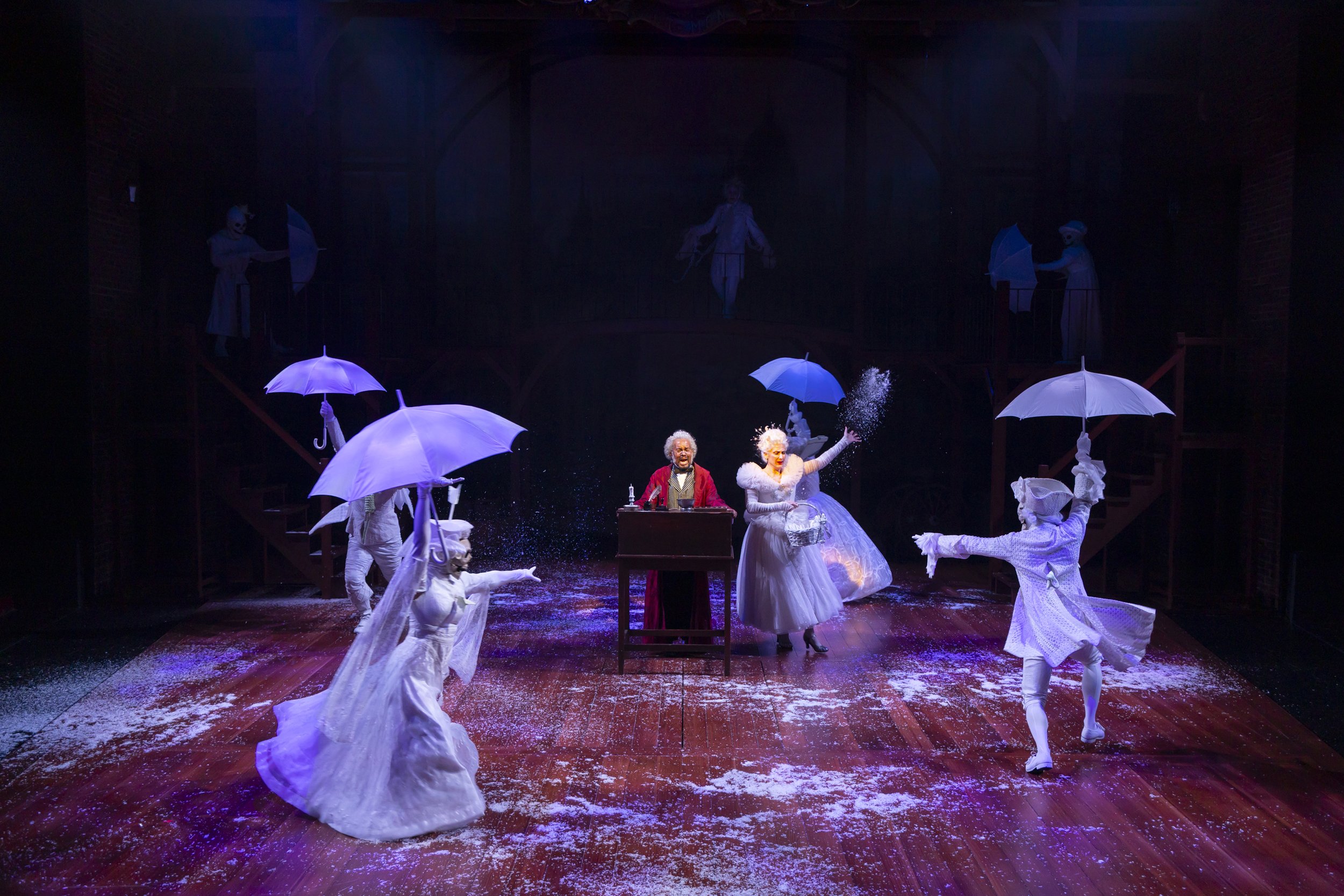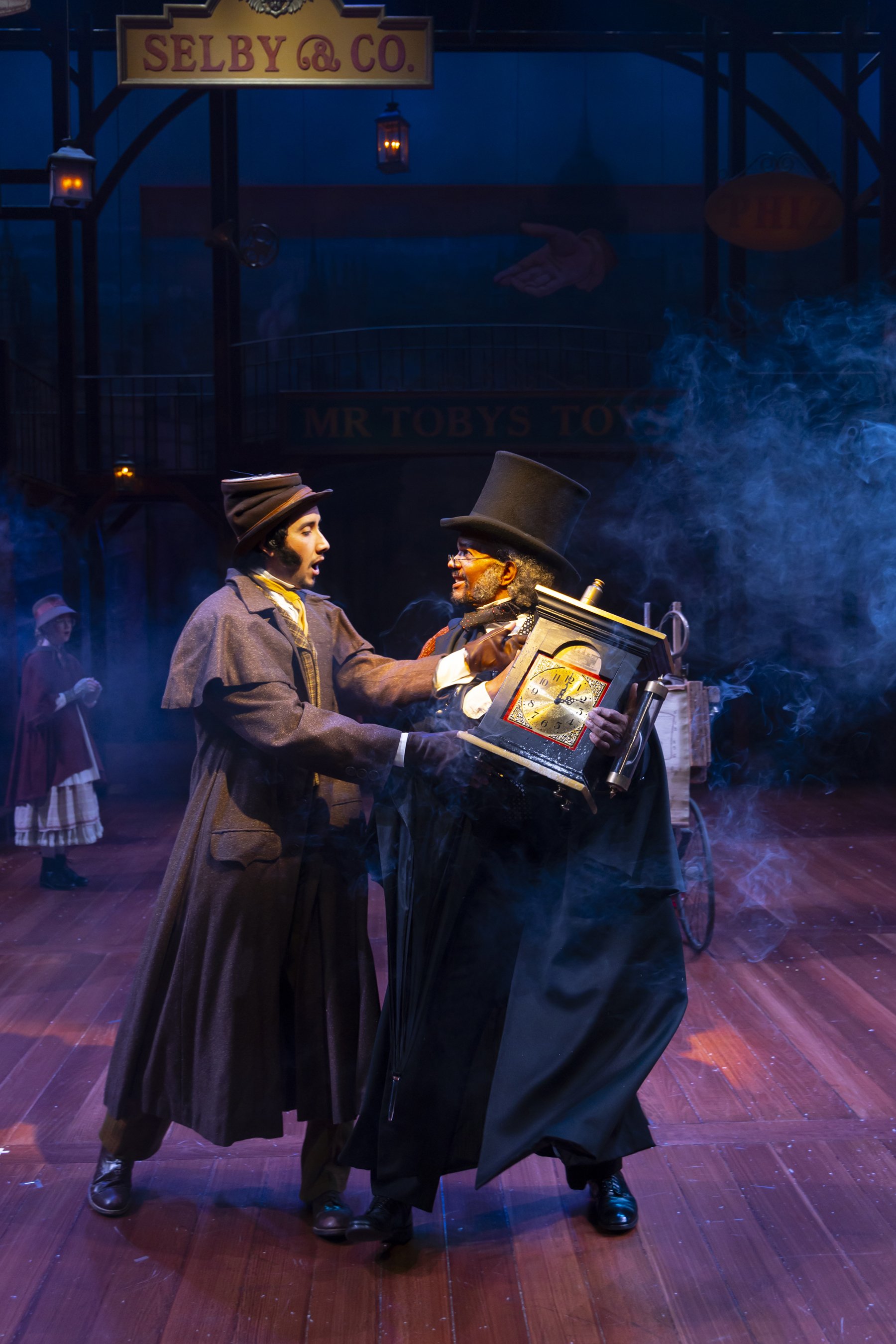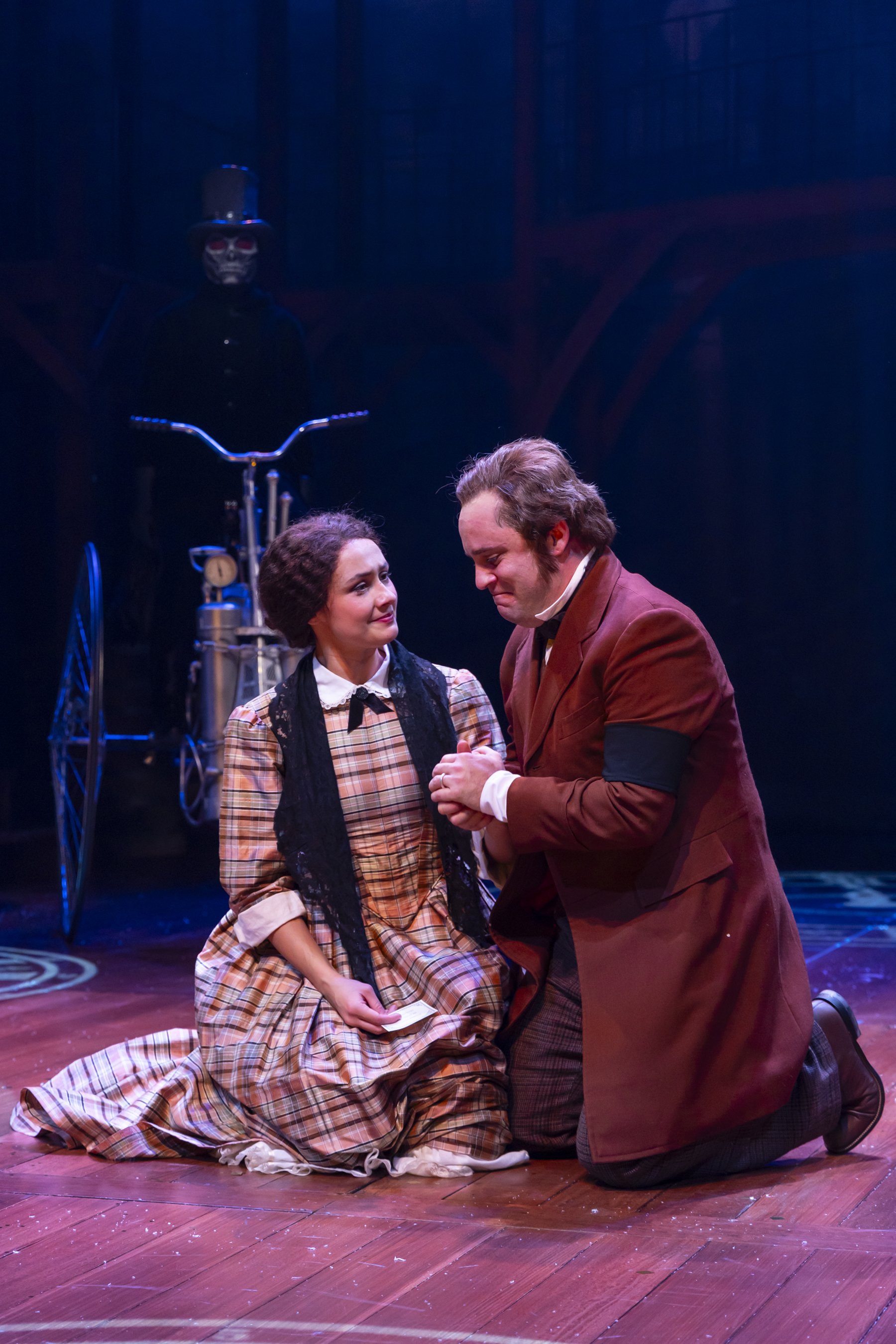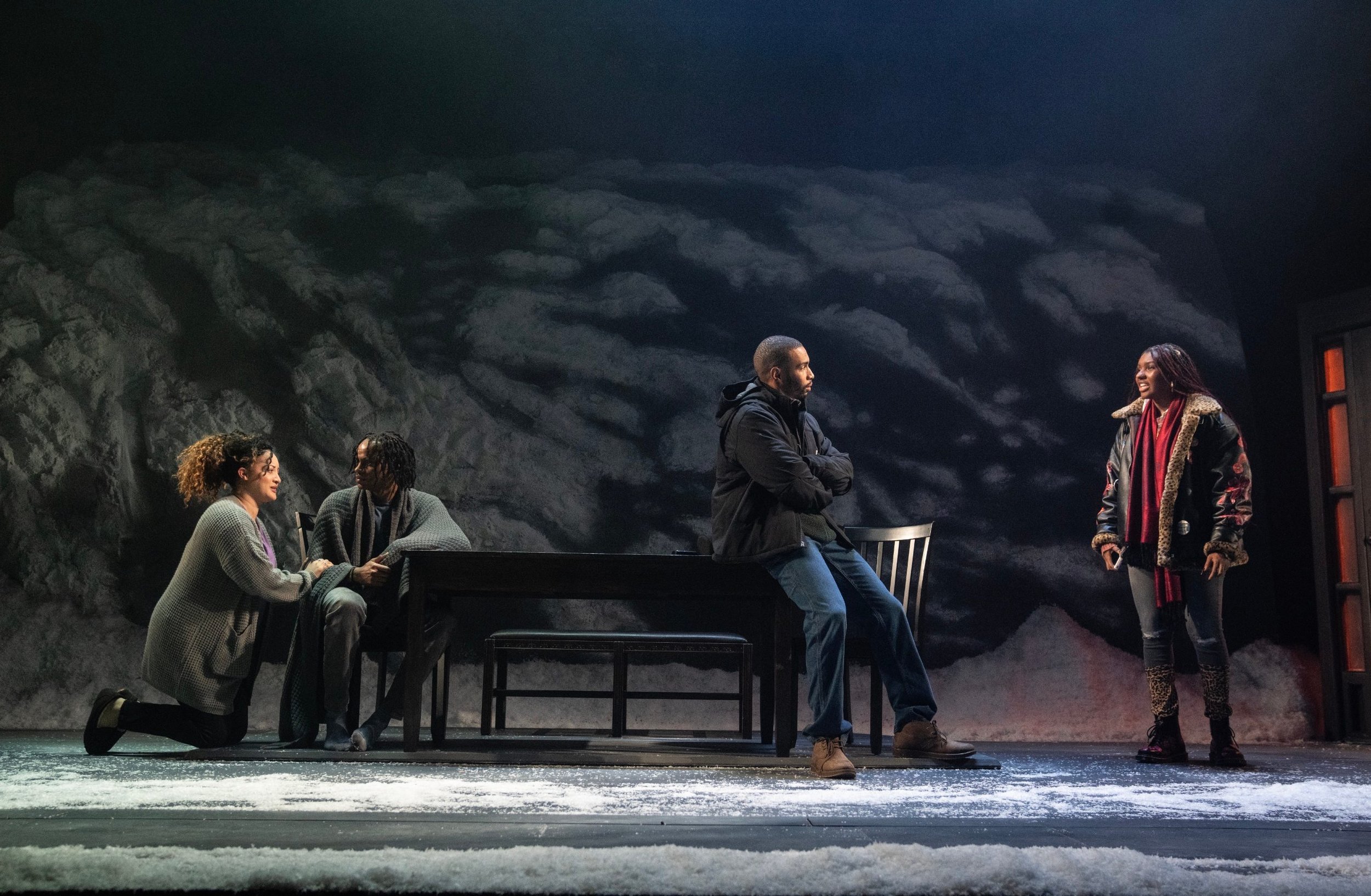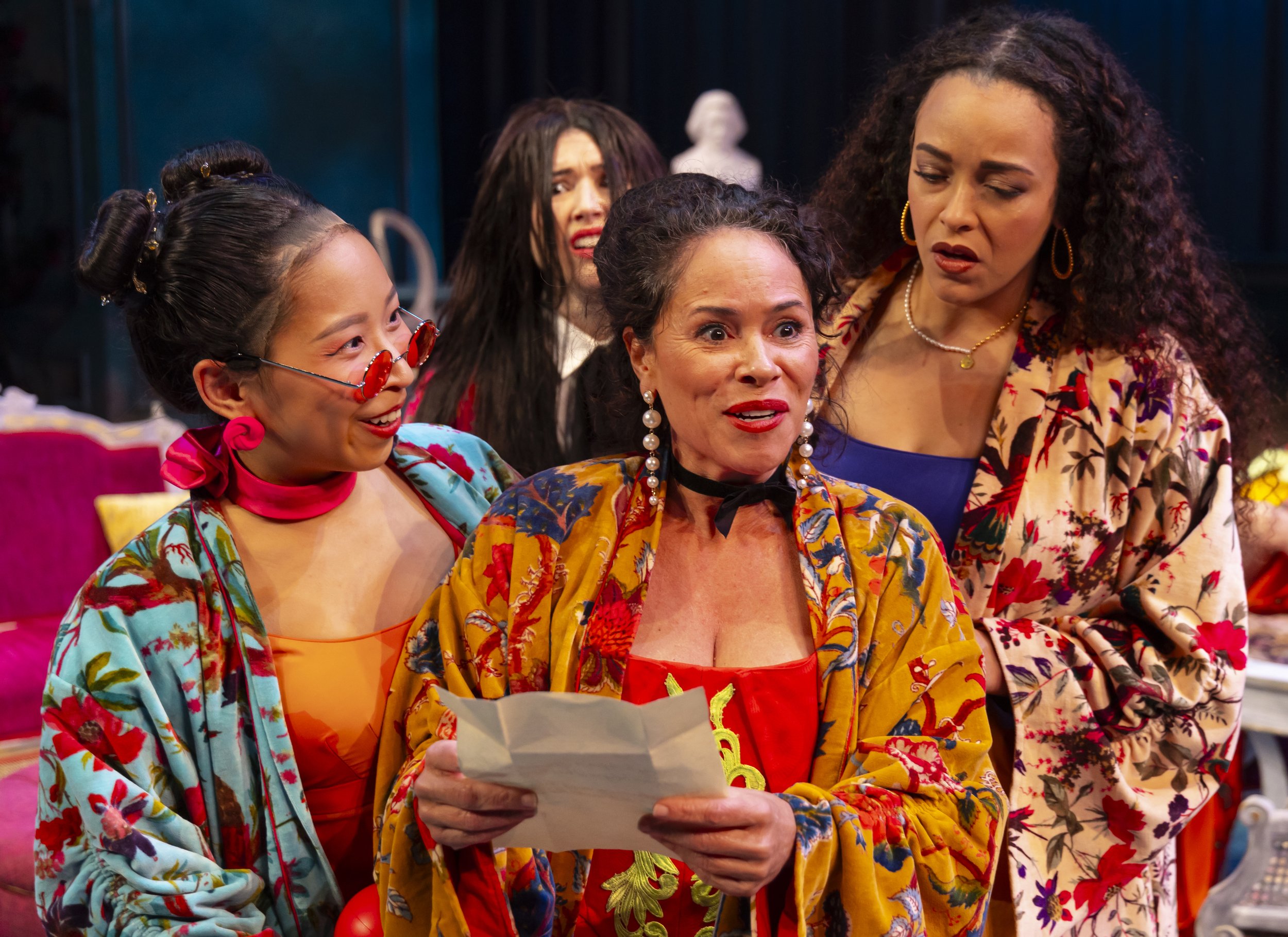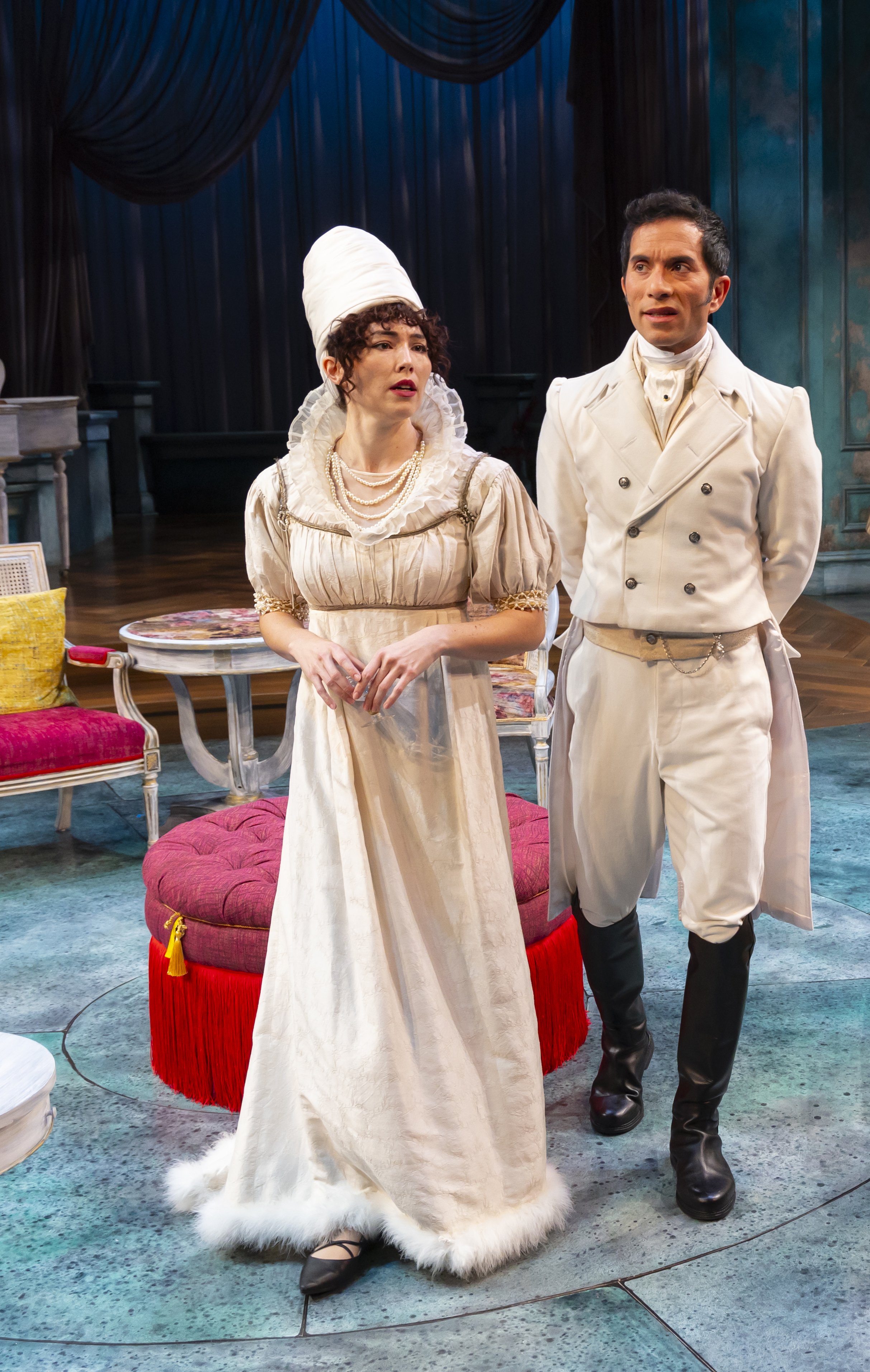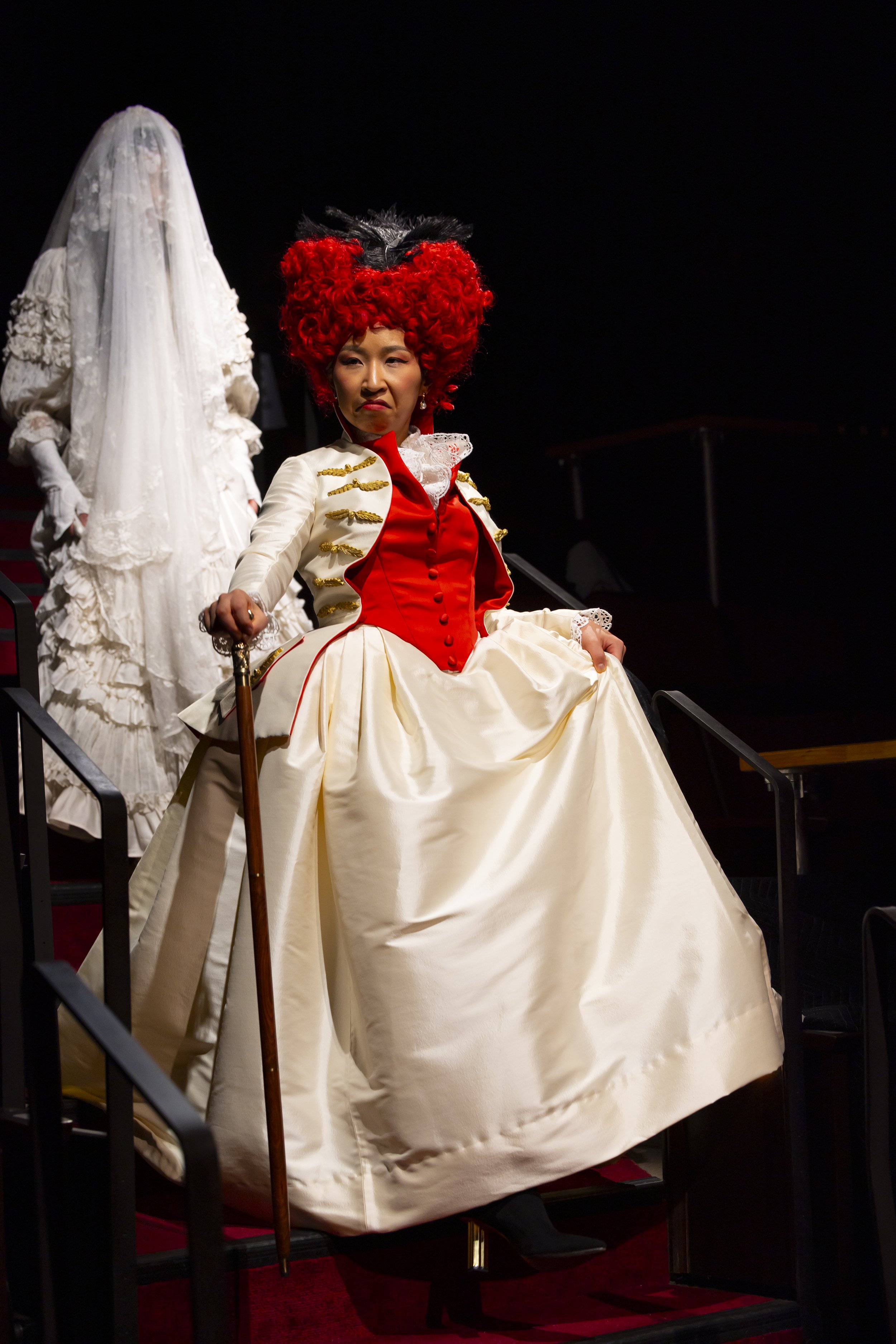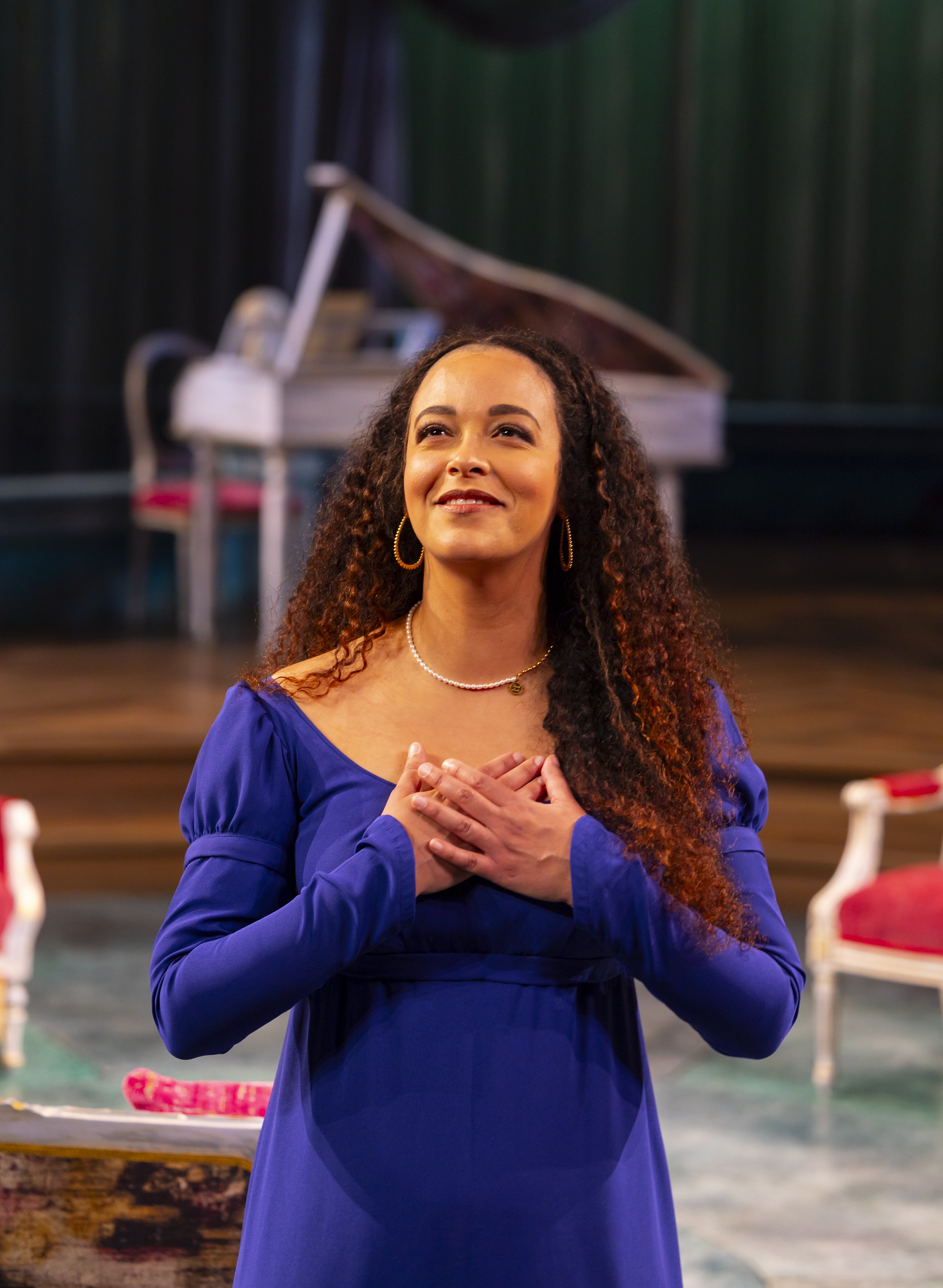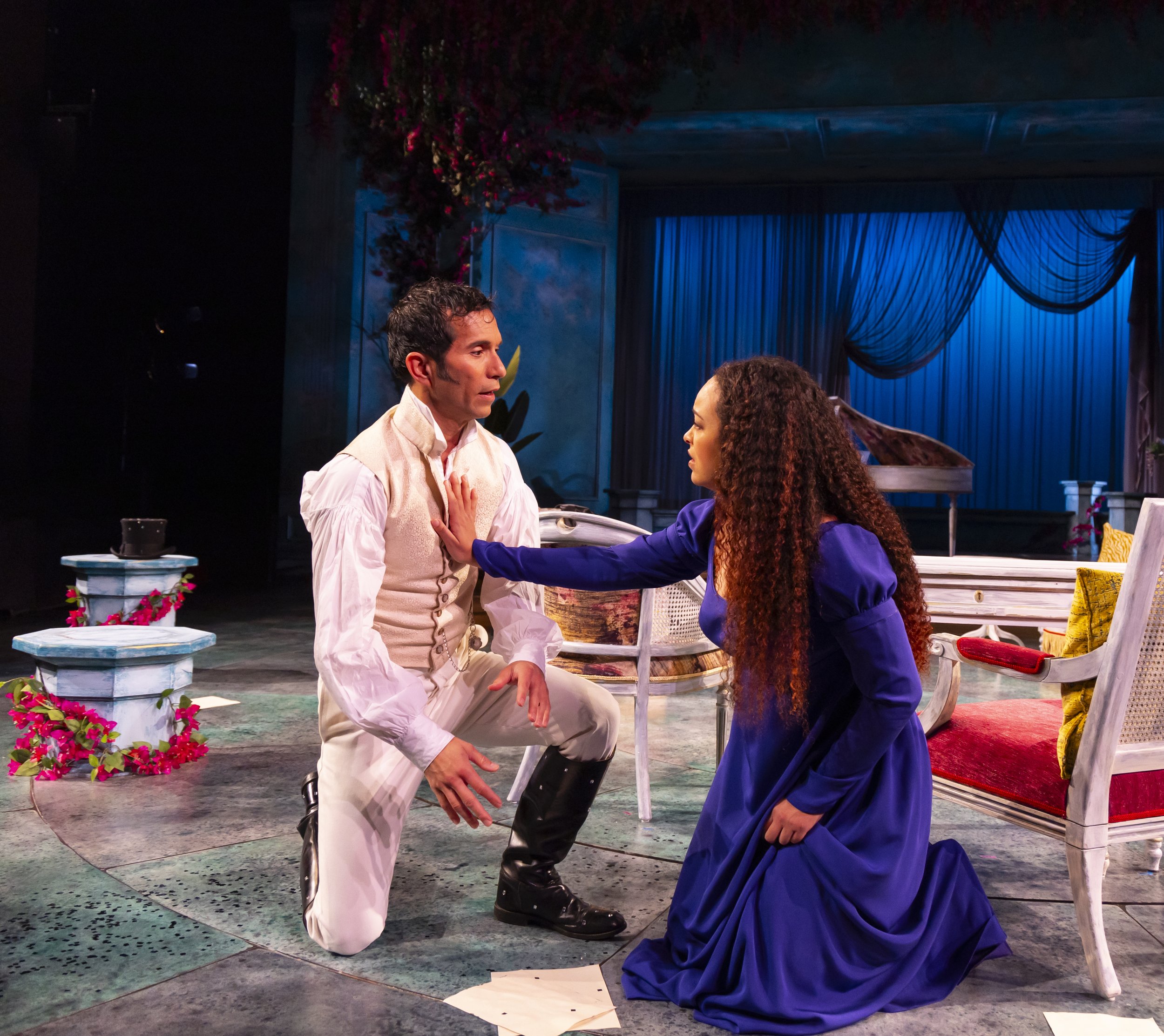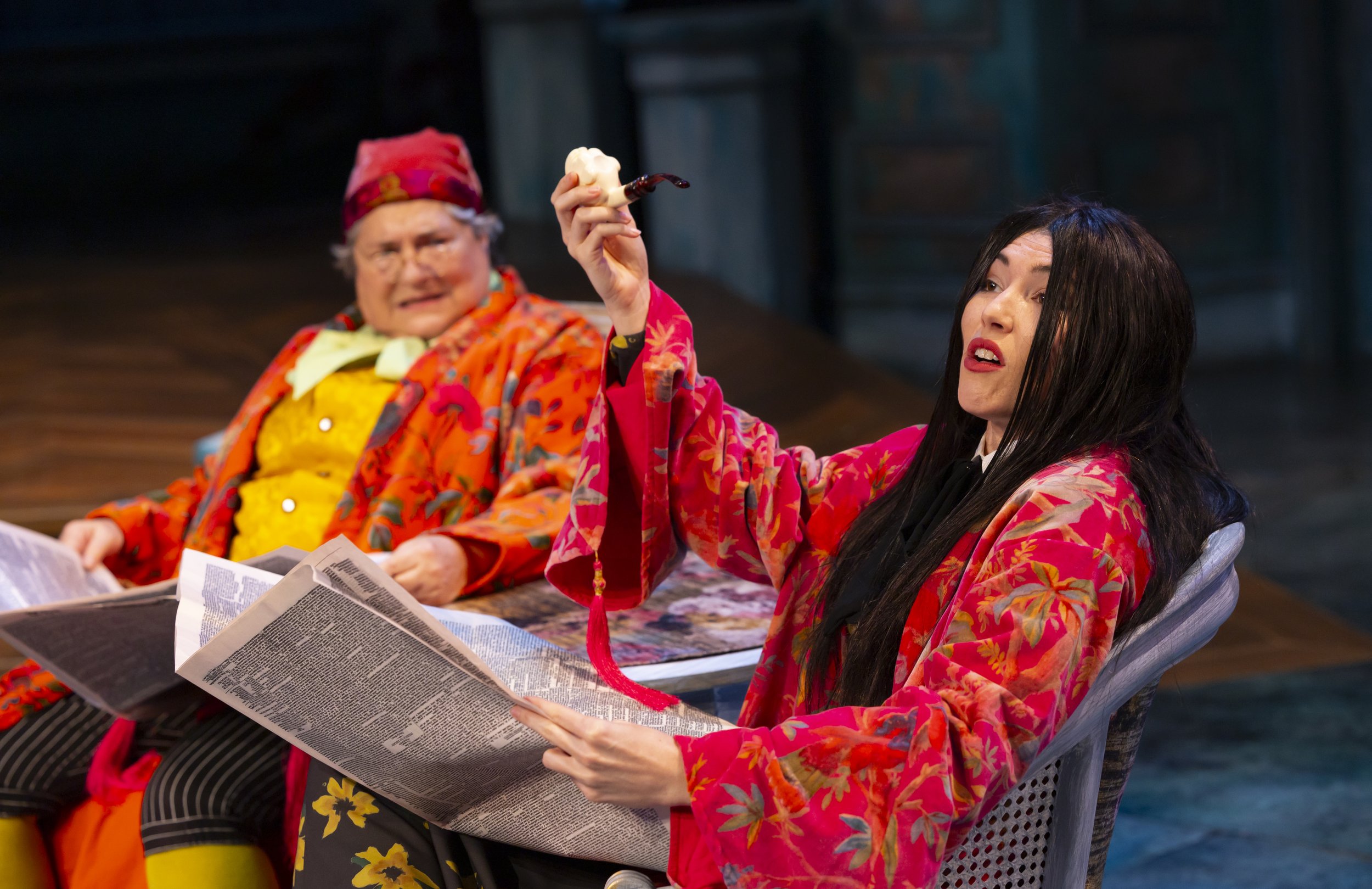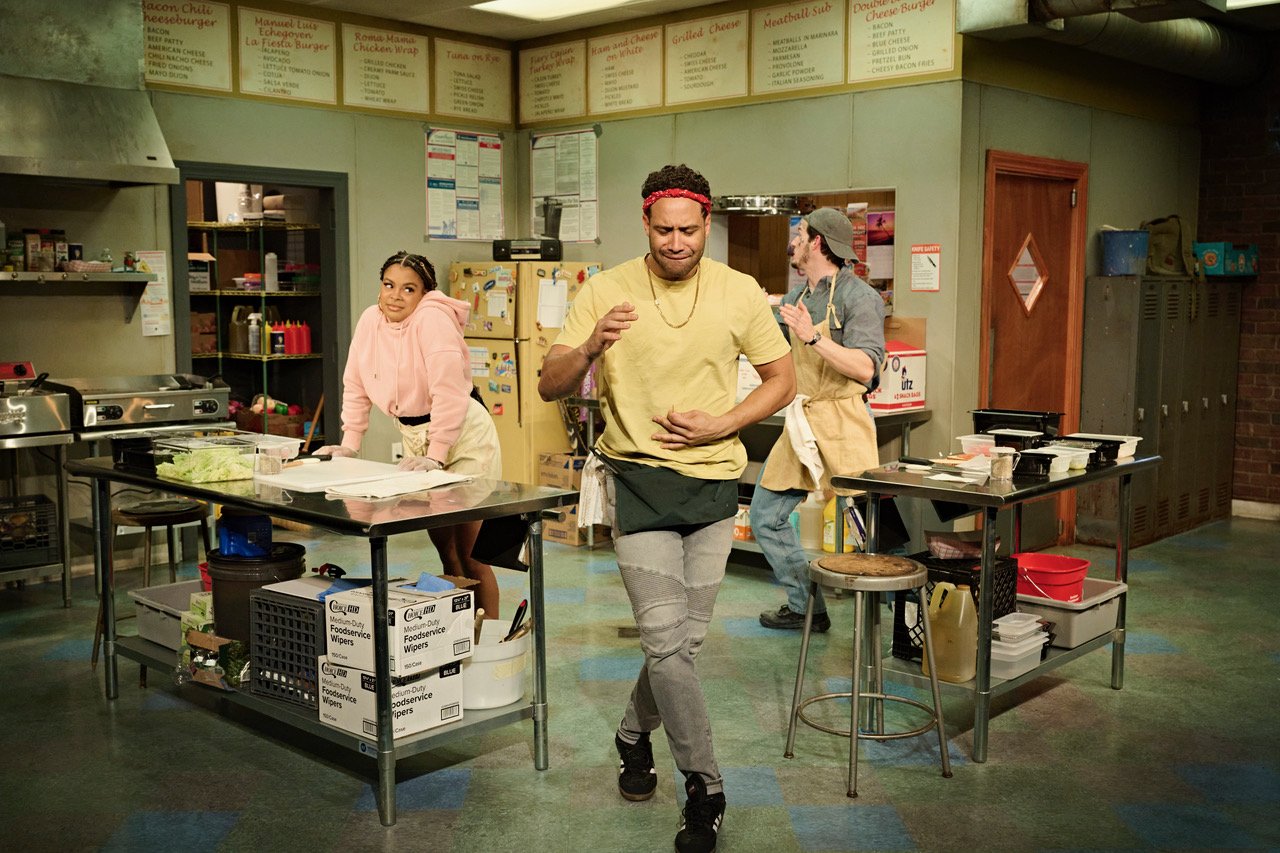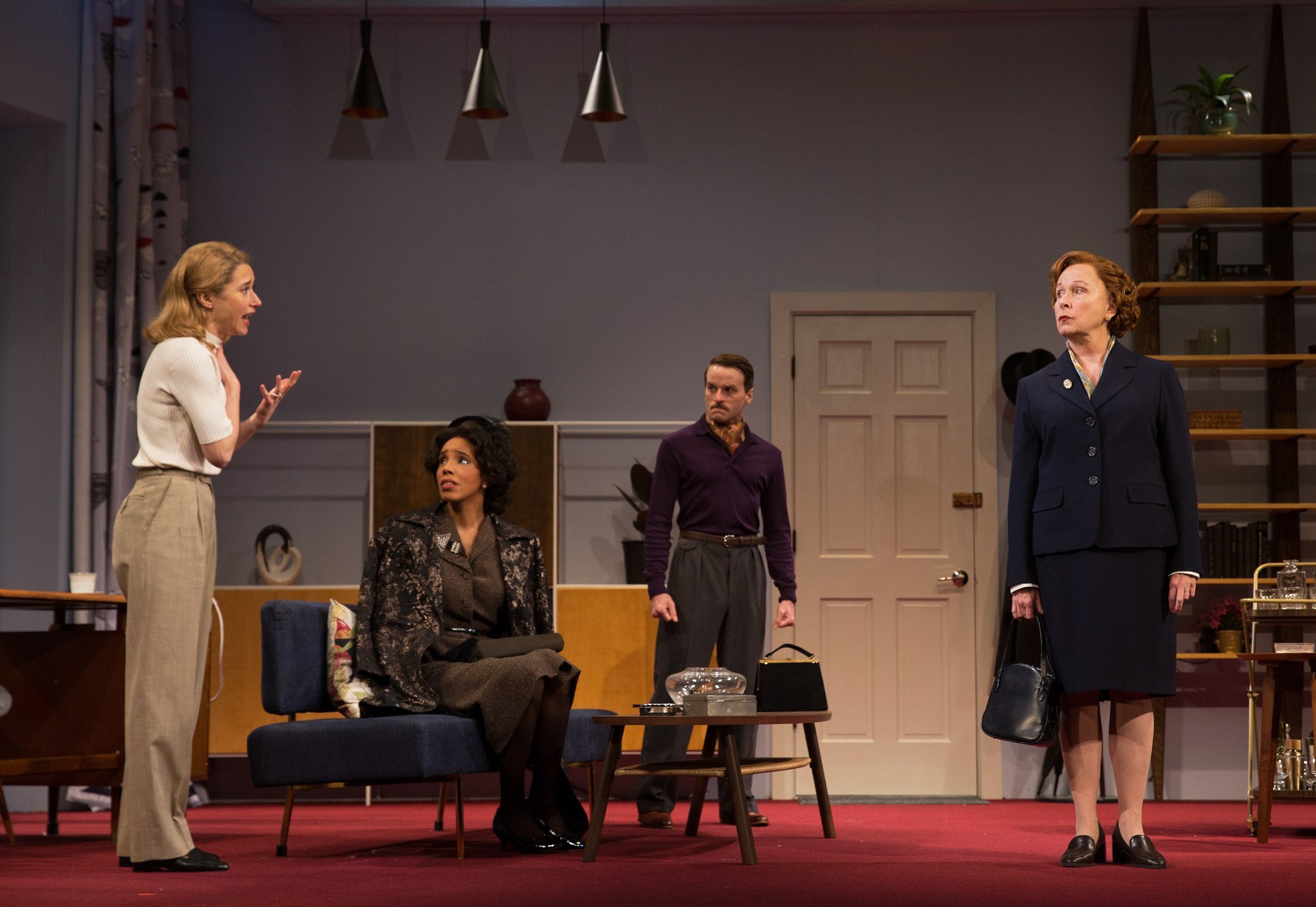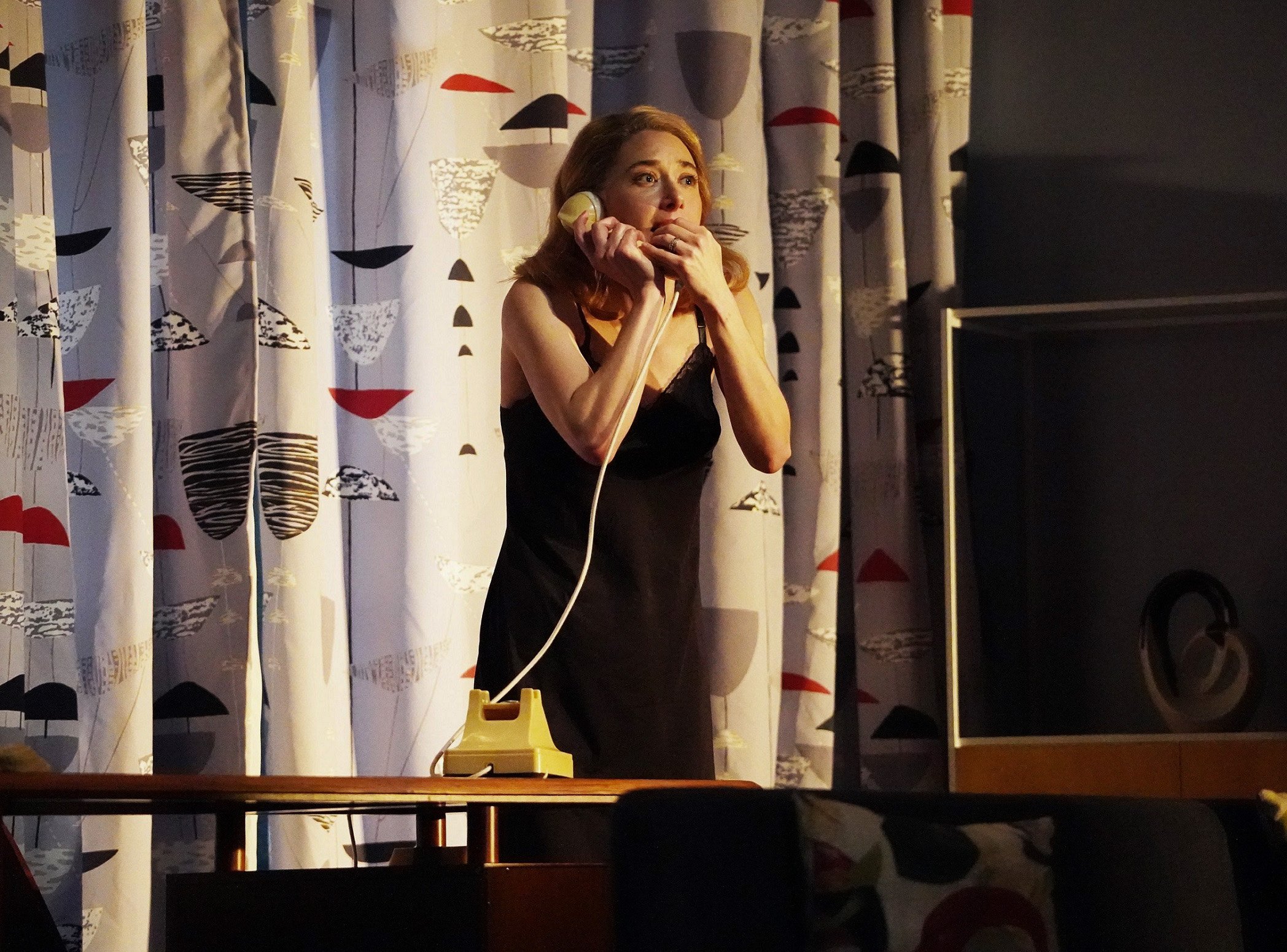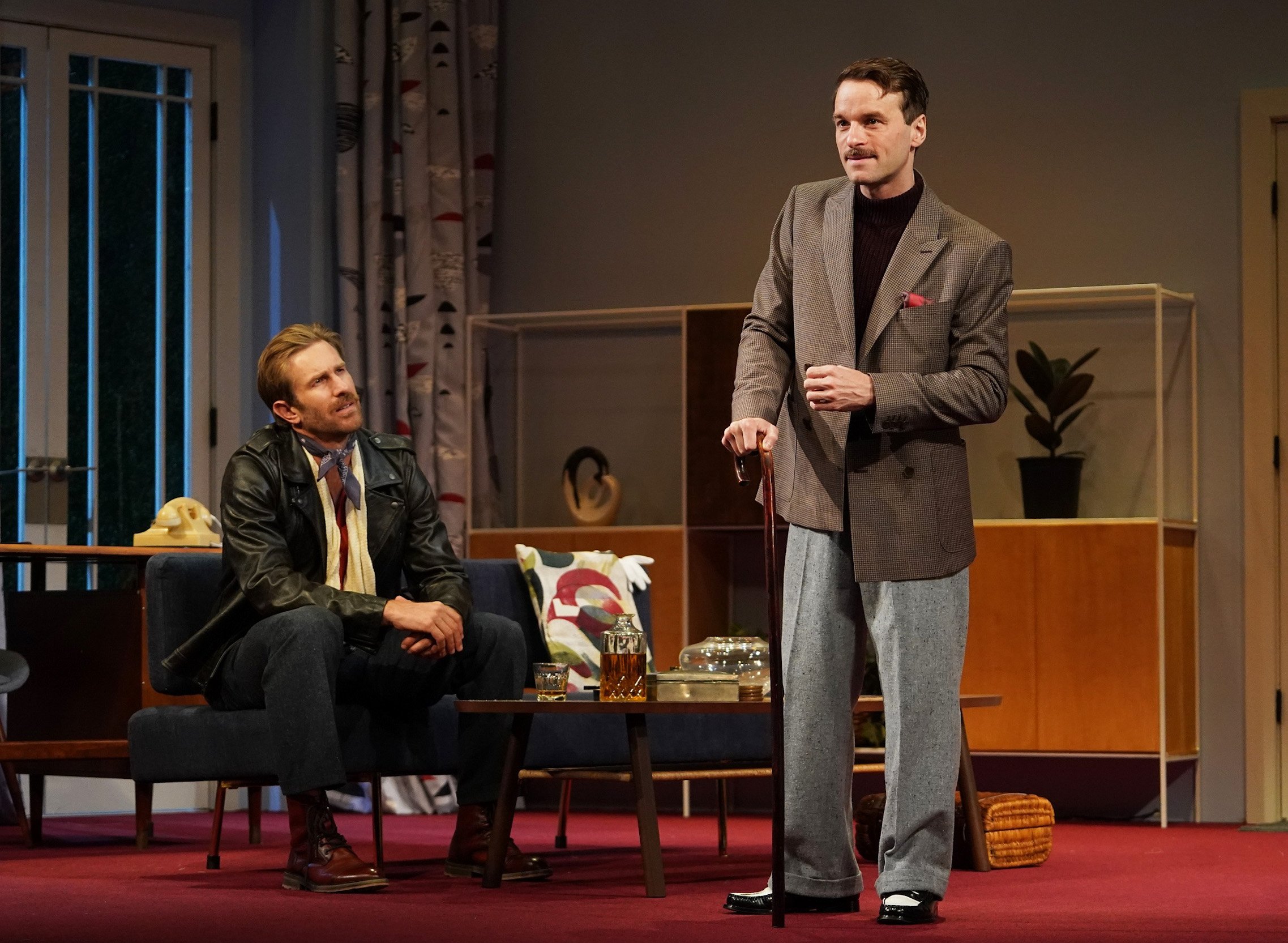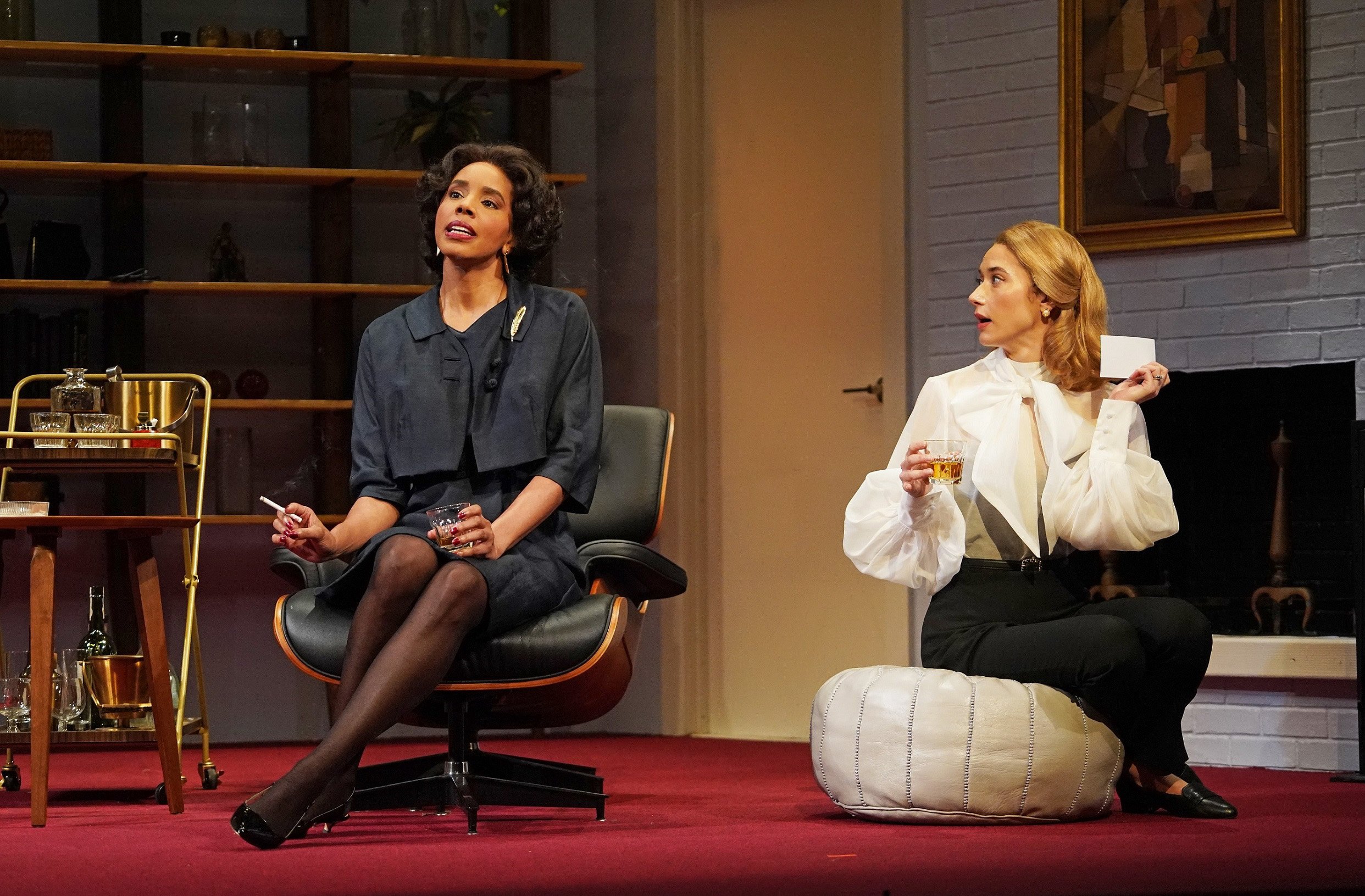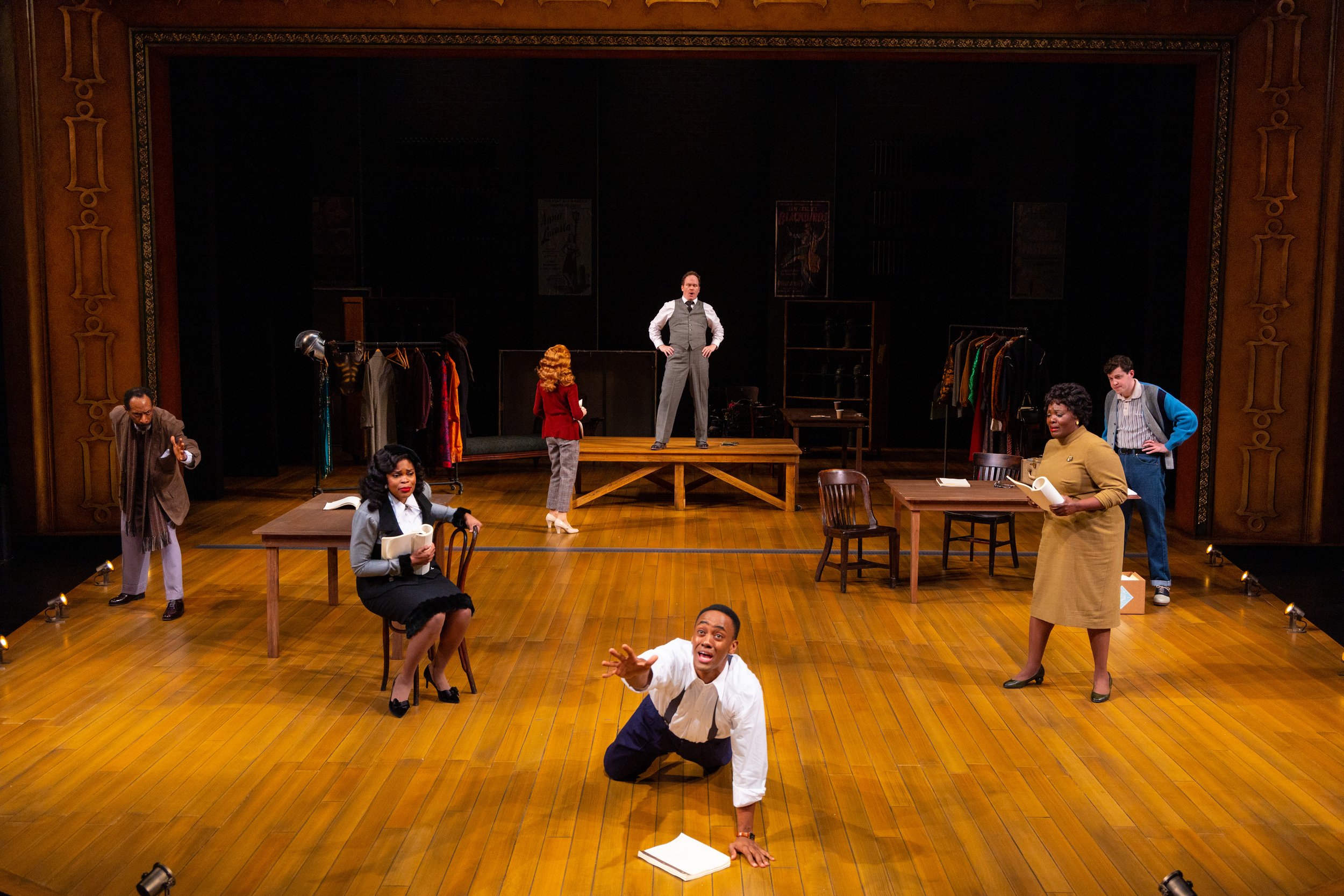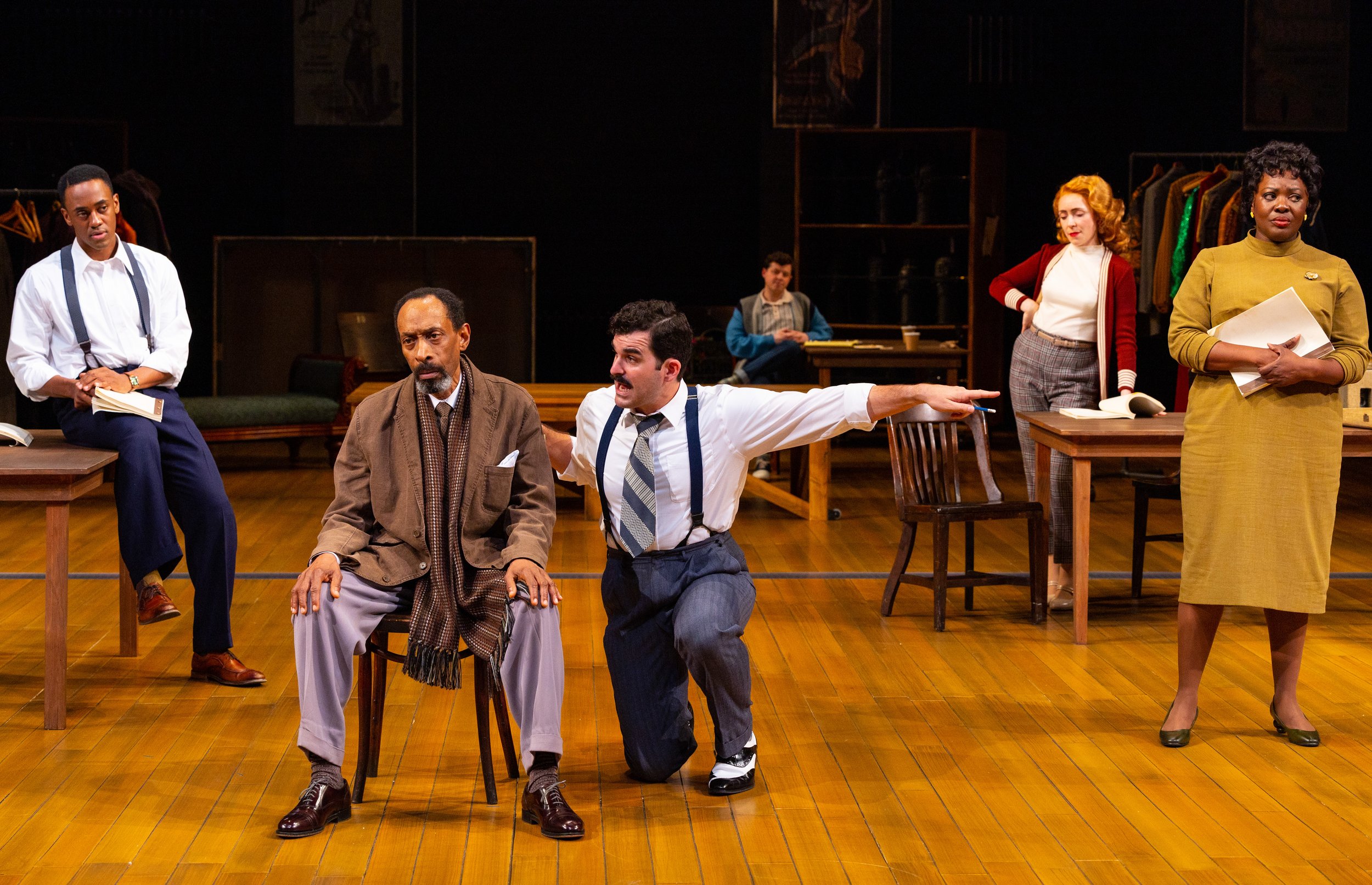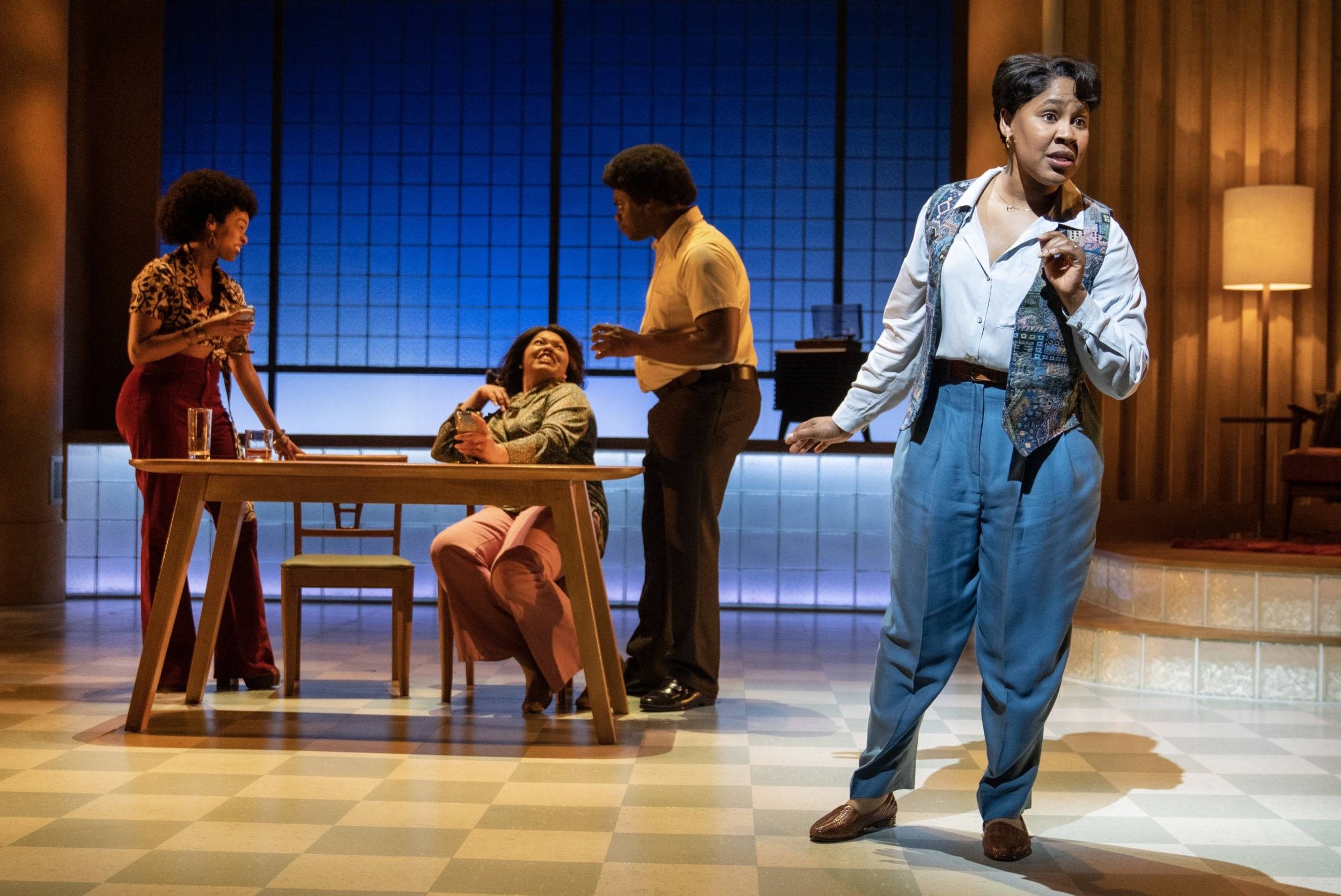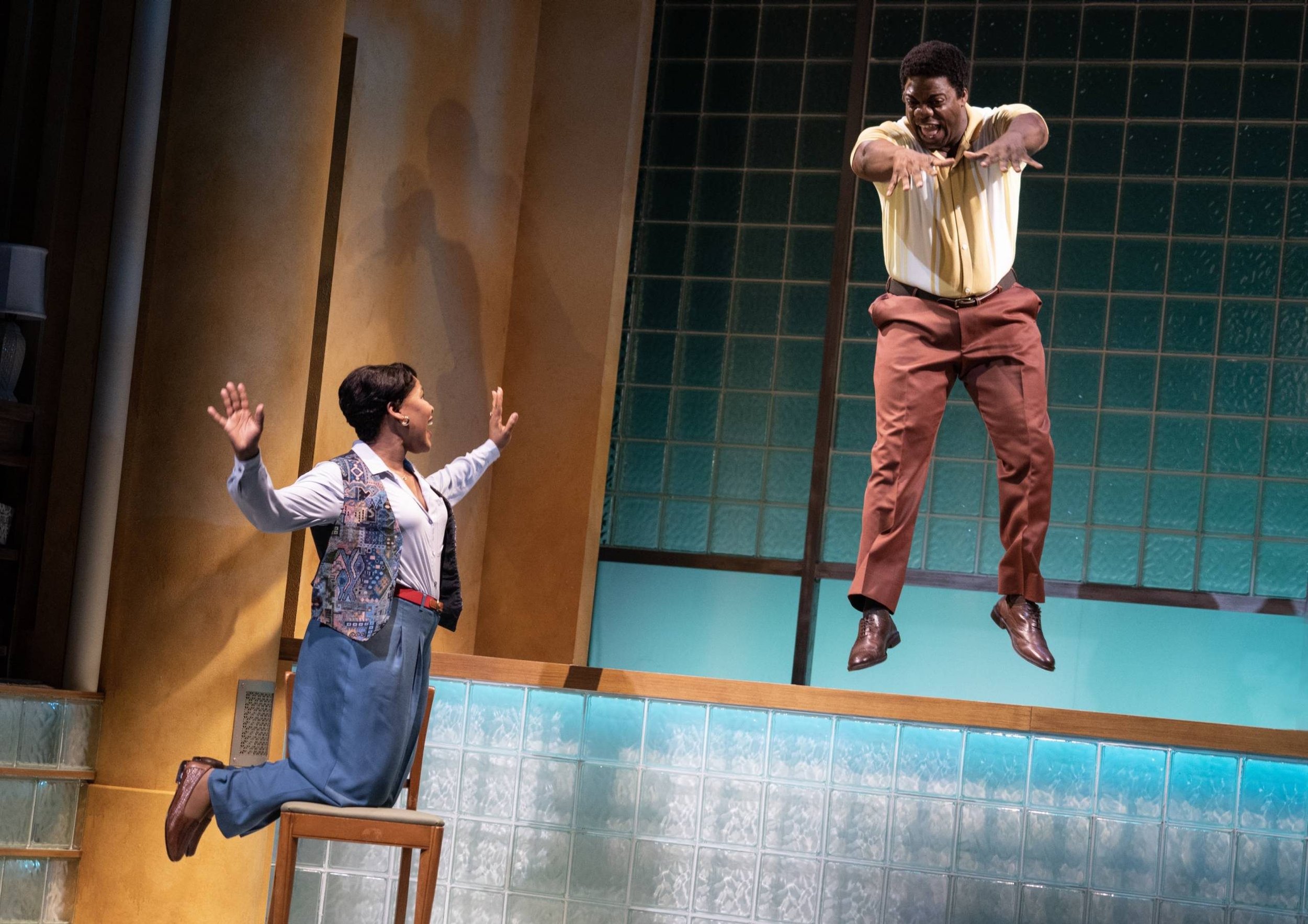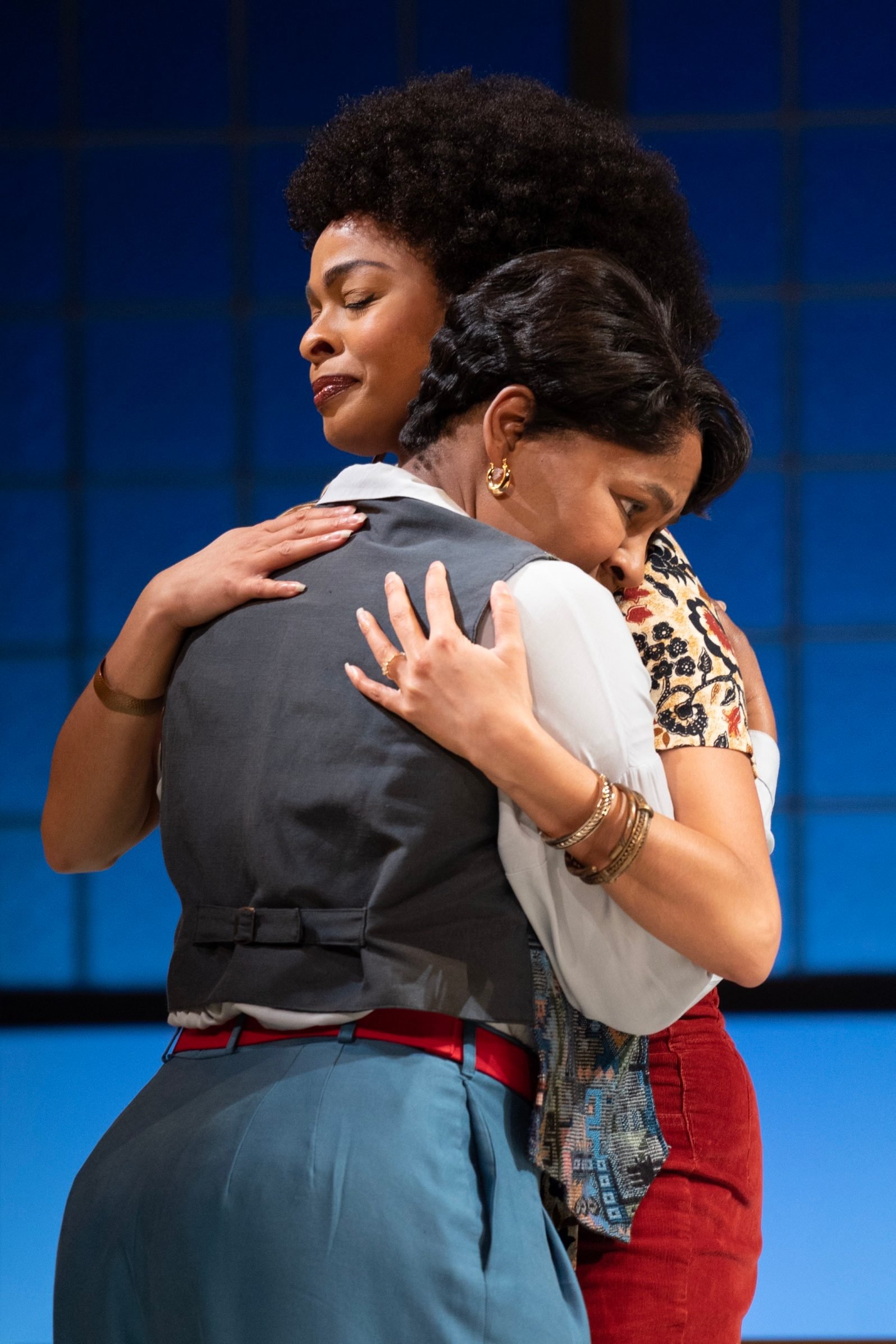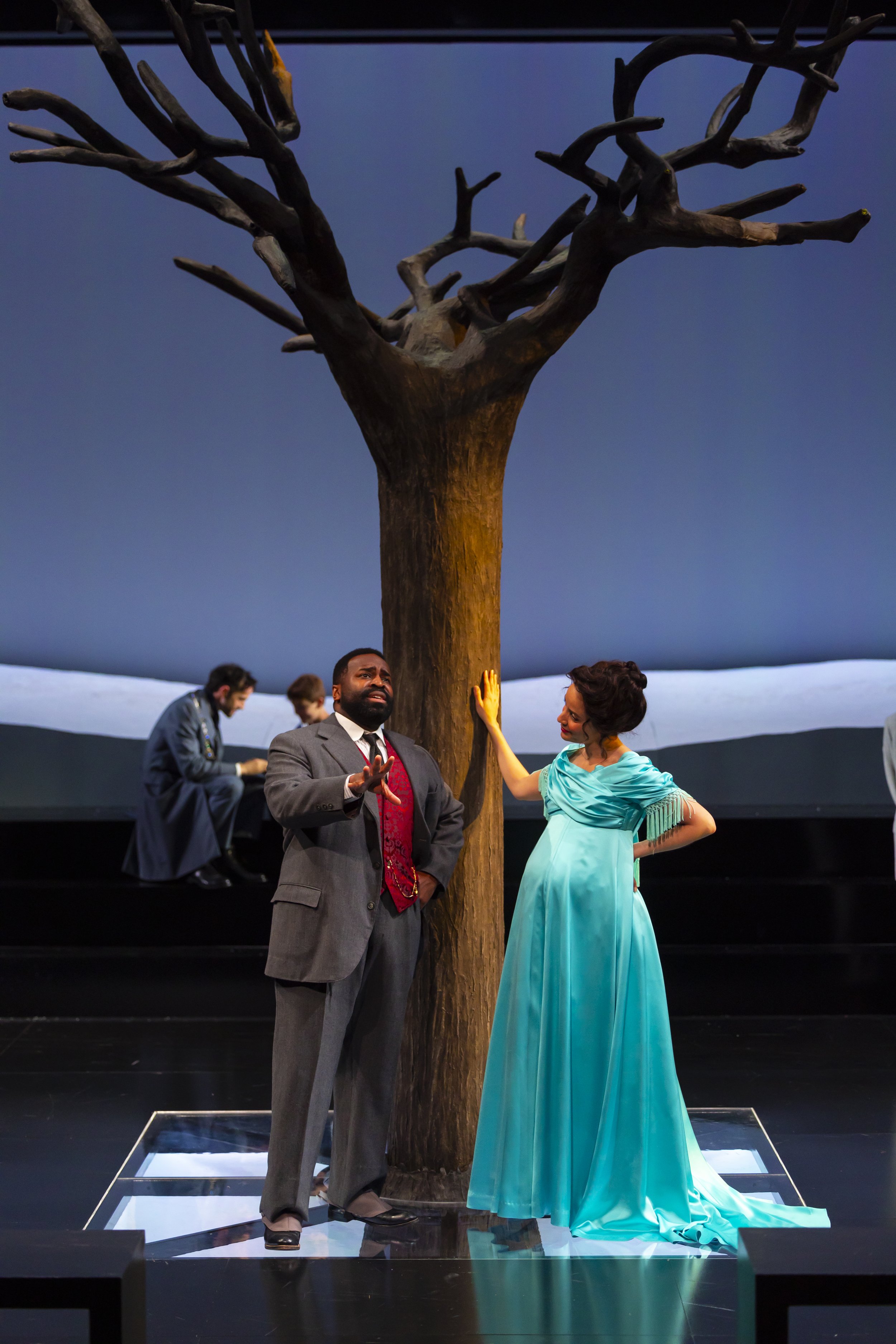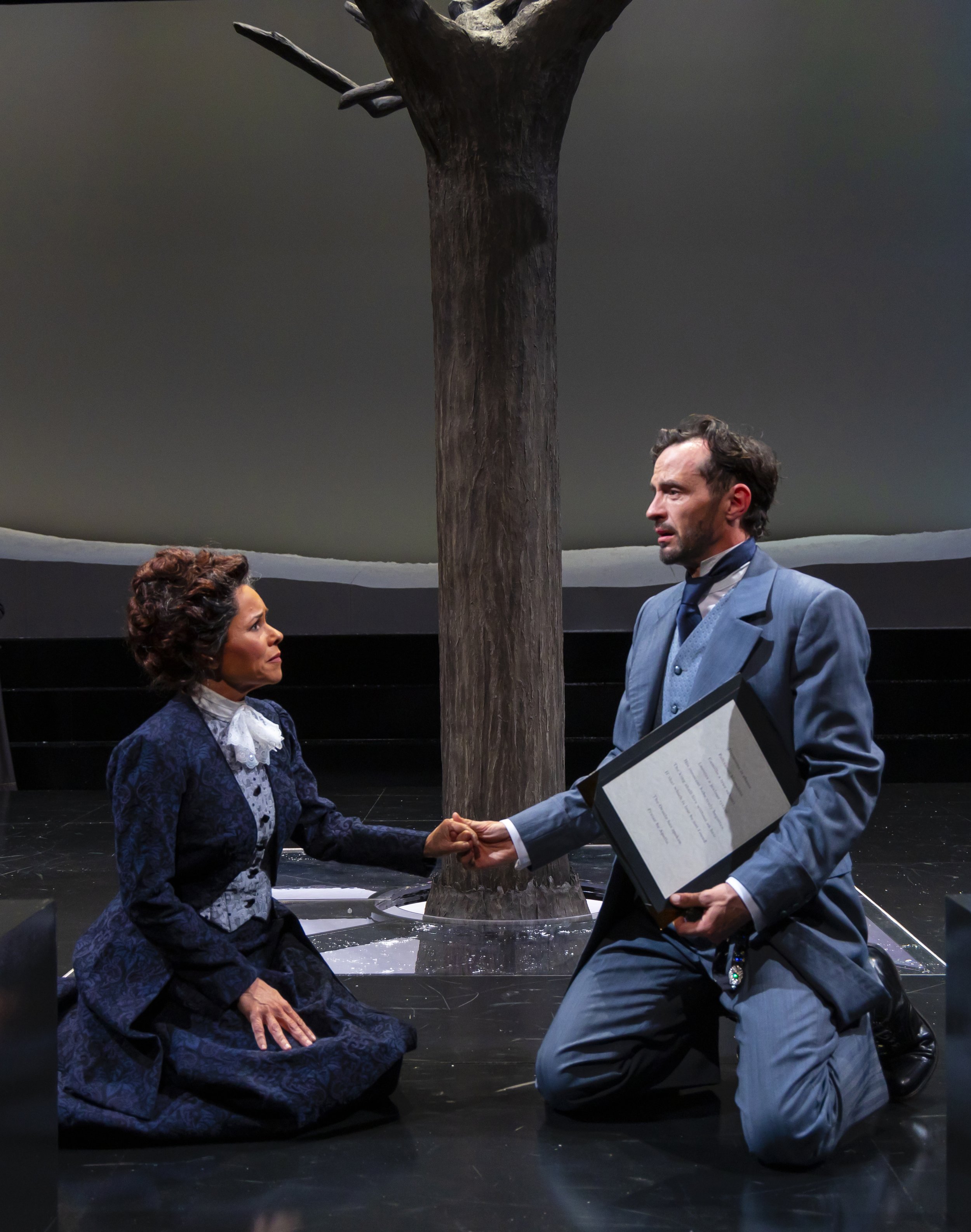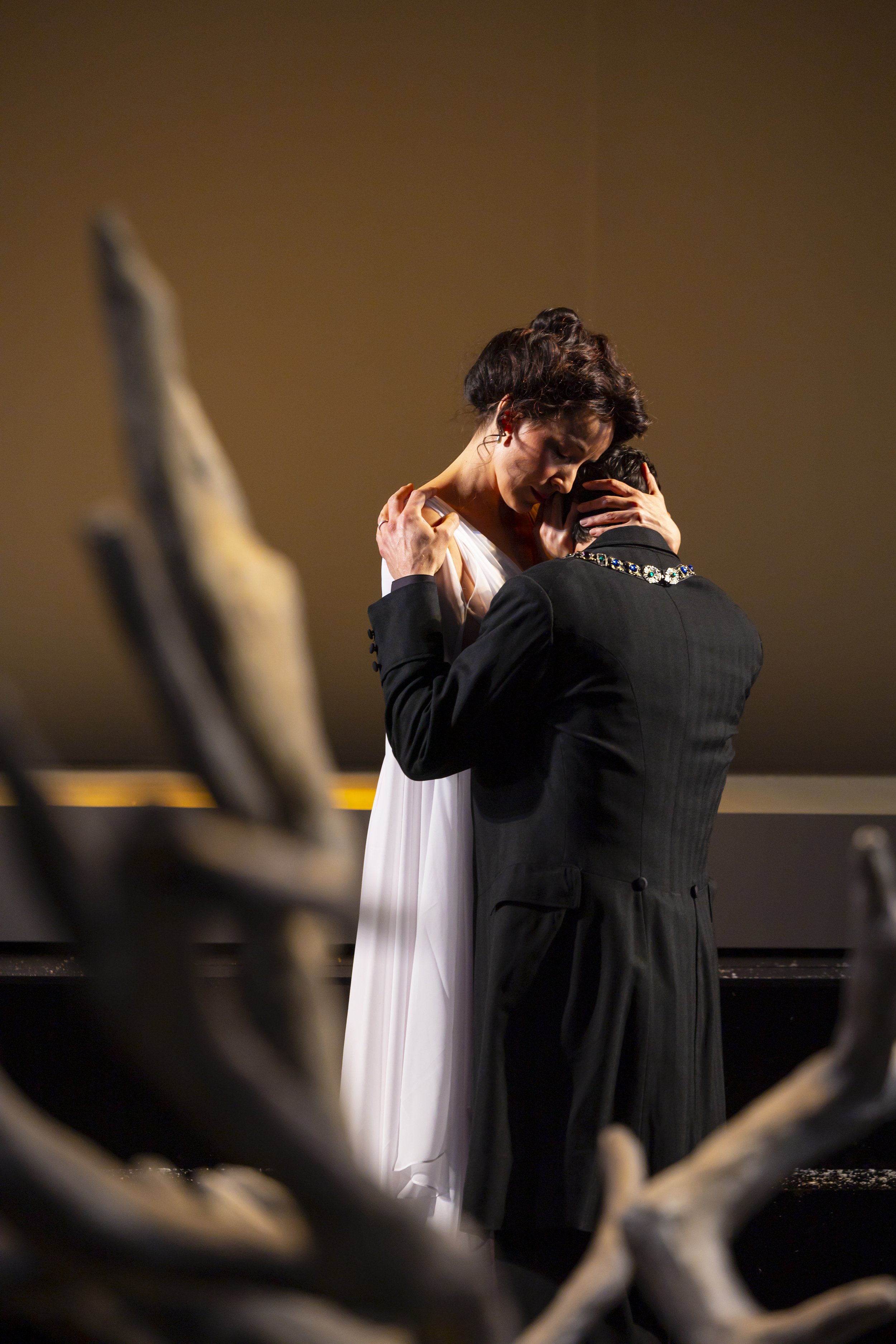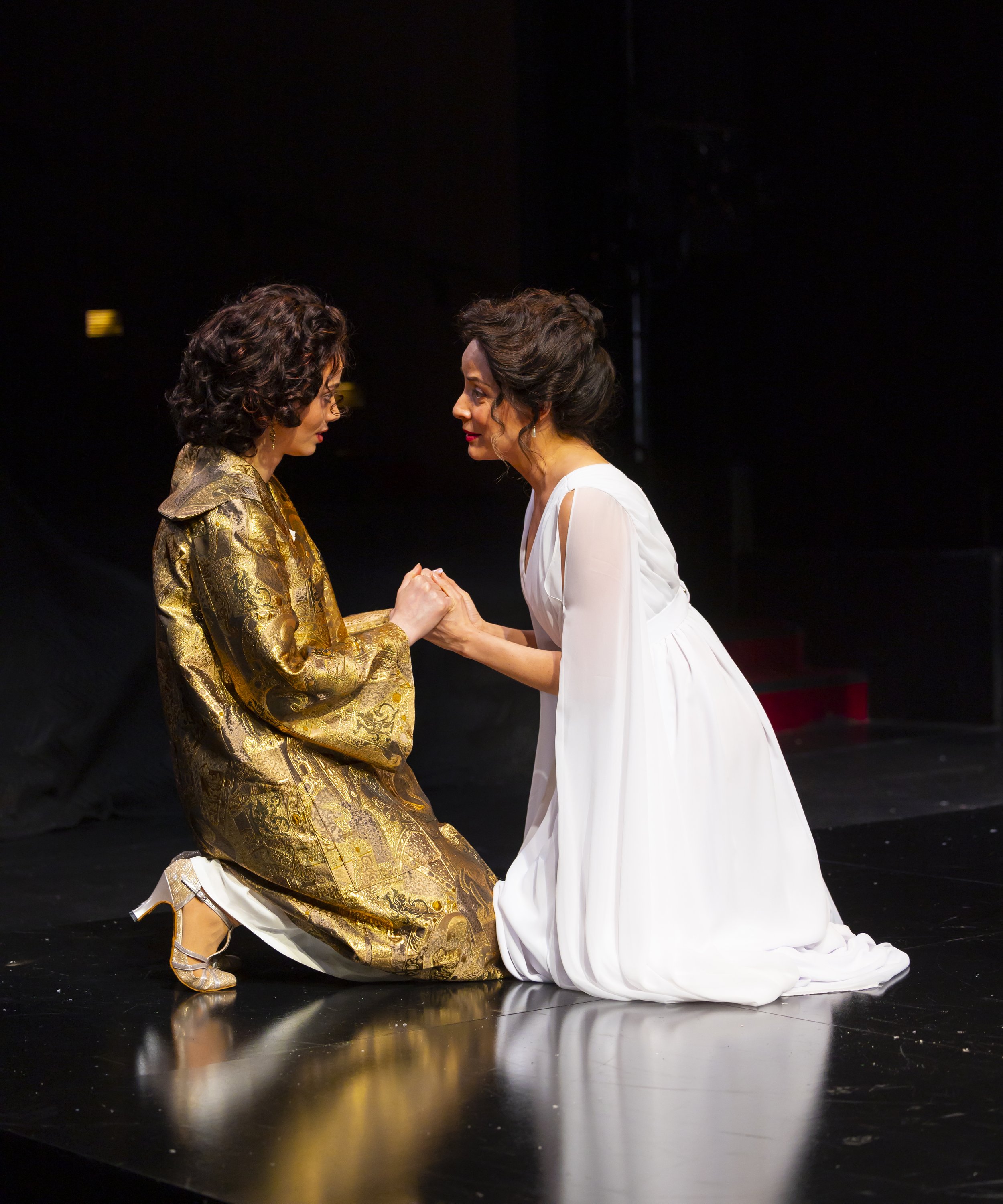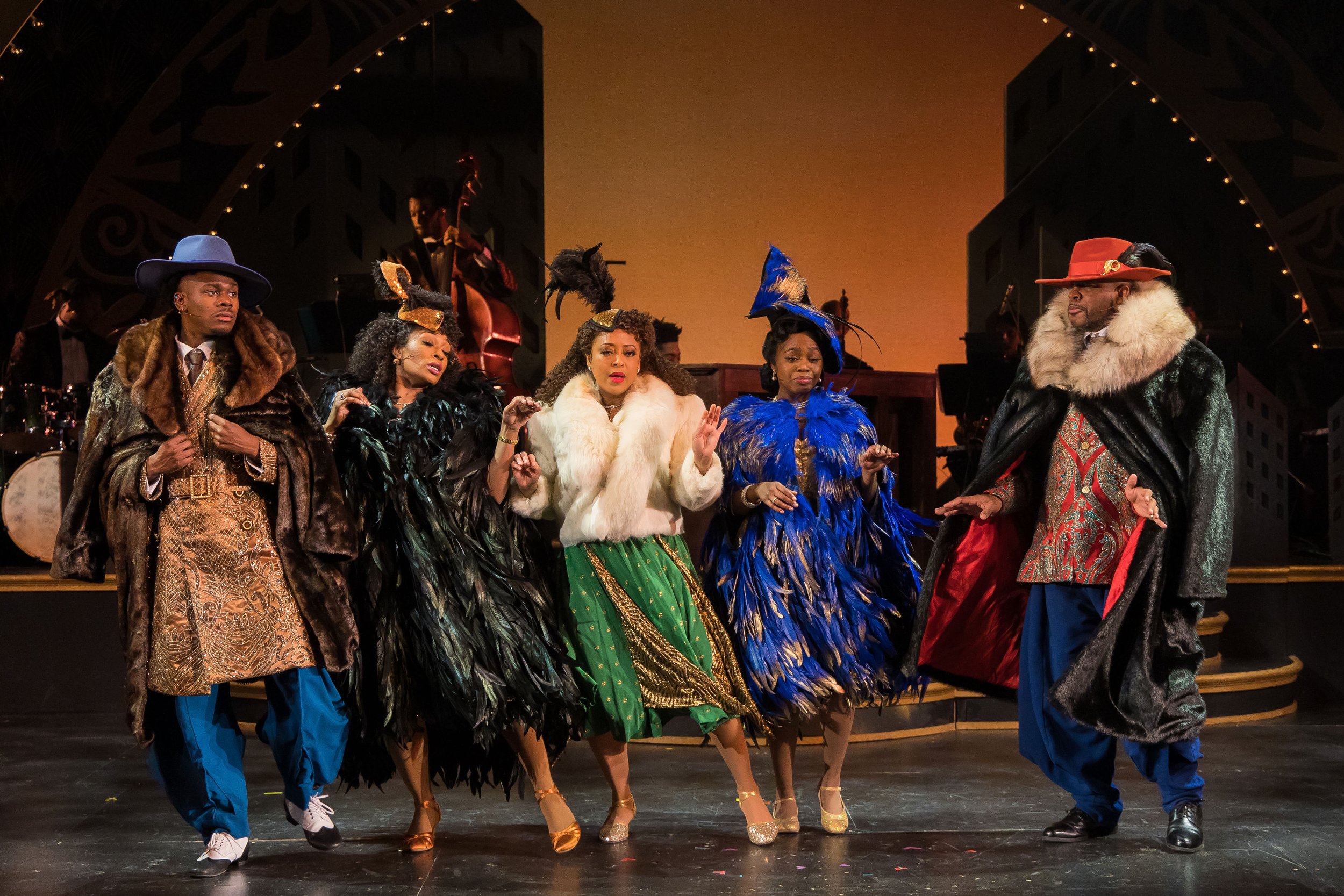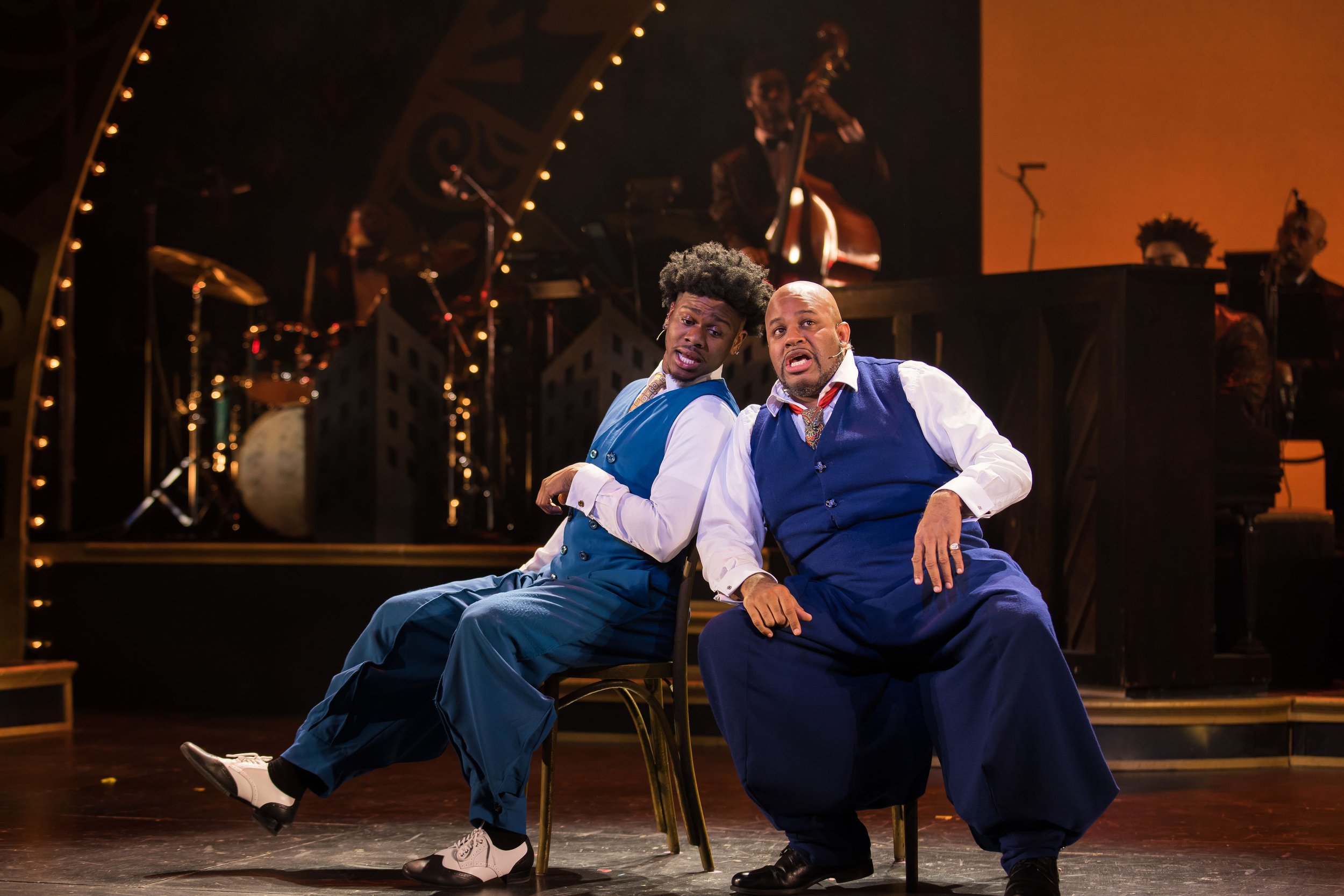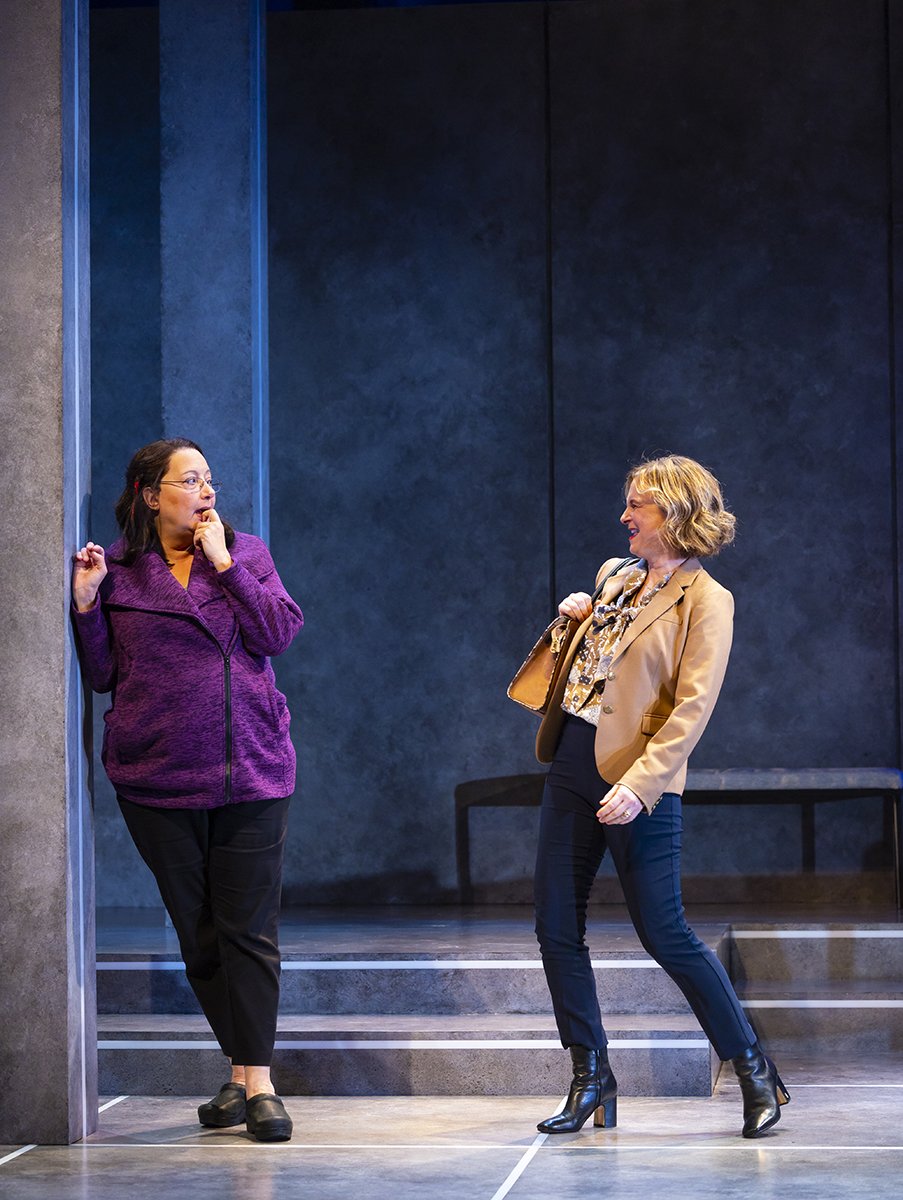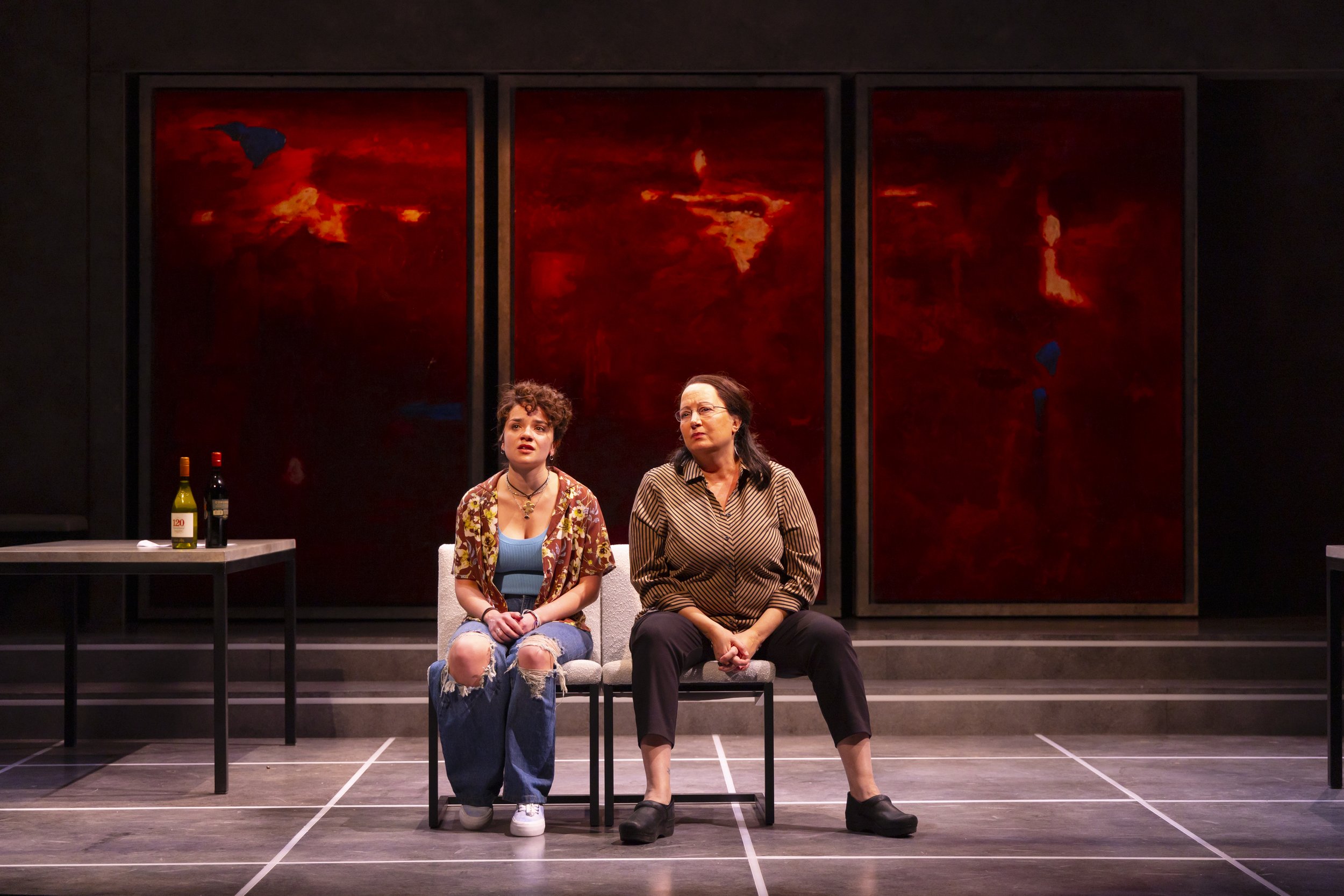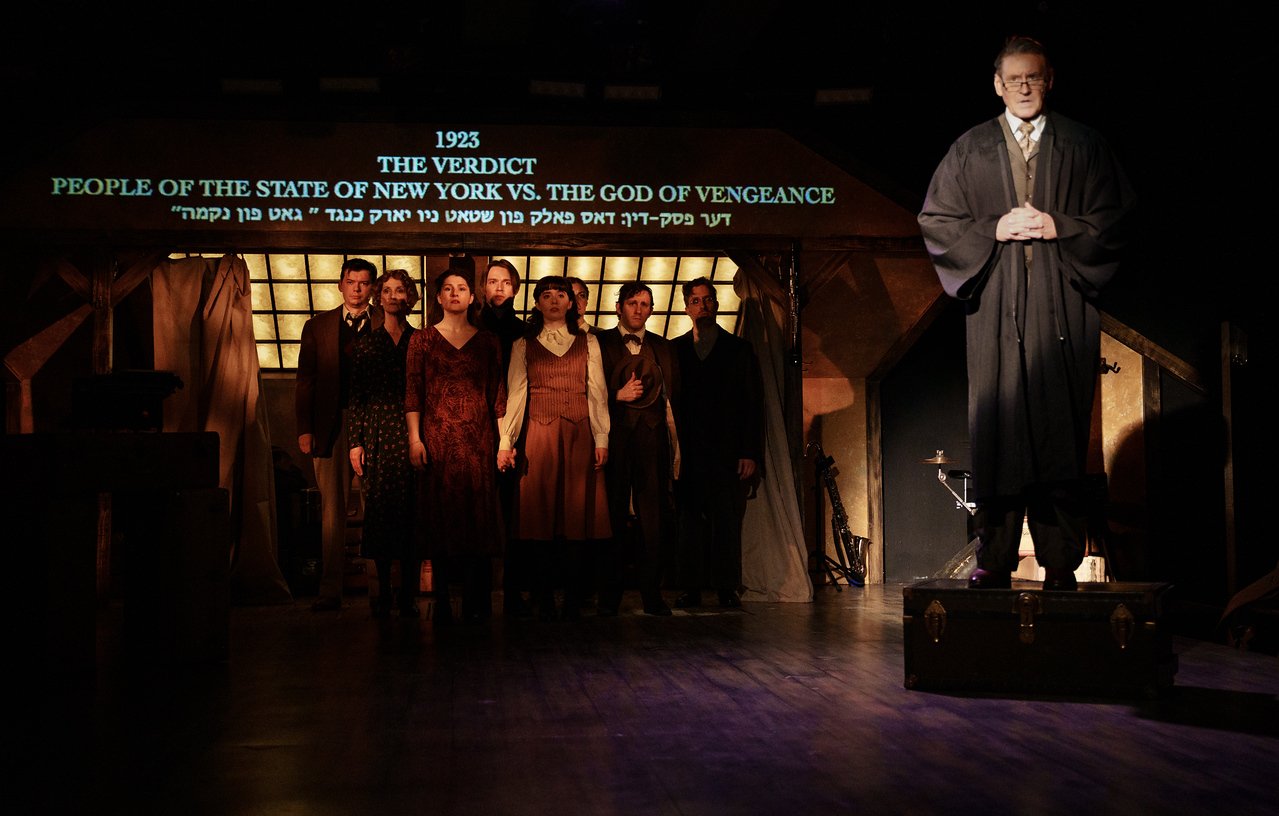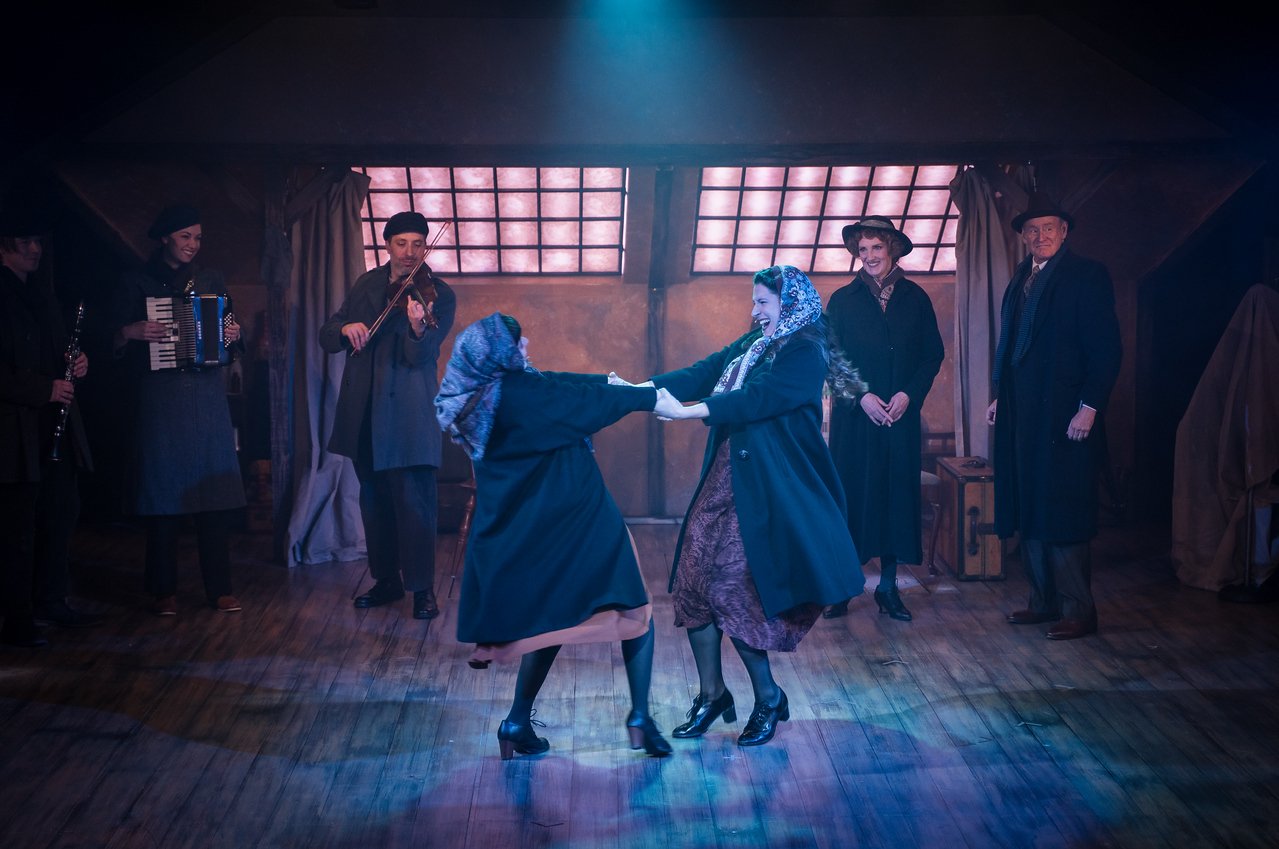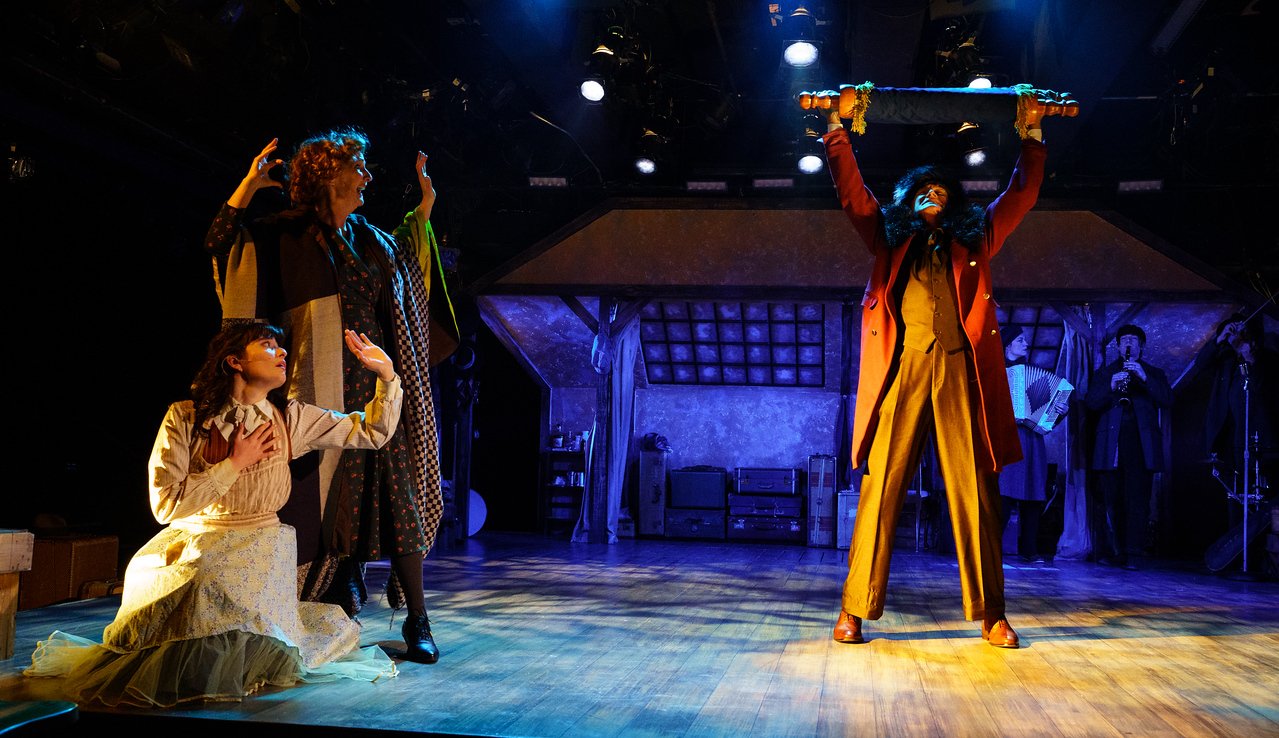Review of A Christmas Carol, A Ghost Story of Christmas, Hartford Stage
Scrooge (Allen Gilmore), The Spirit of Christmas Past (Rebecka Jones), and Apparitions in Hartford Stage’s A Christmas Carol, adapted and directed by Michael Wilson (photo by T. Charles Erickson)
It’s been three years since Hartford Stage last mounted its classy and classic version of Charles Dickens’ A Christmas Carol, and so this year’s revival might feel to some like a ghost of Christmases past. To aid that feeling, Michael Wilson, the original adapter-director of the show back in 1998, has returned to the helm. But, in the interests of a wrinkle in time that alters everything, this version casts veteran comic Shakespearean actor Allen Gilmore as the hardened miser Ebenezer Scrooge, the scourge of Christmas who comes to learn the value of being kind to his fellow creatures on this distracted globe.
Scrooge (Allen Gilmore) and passers-by (members of the youth ensemble) in Hartford Stage’s A Christmas Carol, adapted and directed by Michael Wilson (photo by T. Charles Erickson)
If you’ve lived in Connecticut for more than three years and haven’t ventured from the confines of your “money-changing hole” (or its equivalent) to see Hartford Stage’s A Christmas Carol, you may be a bit of a humbug yourself, at least where Christmas and theater is concerned. The story is oft-told and has been given many fine presentations (Wilson’s adaptation shrewdly relies on the best cinematic version, directed by Brian Desmond Hurst and starring Alastair Sim, from 1951) as we follow Scrooge through a dark night of the soul that gives us living vignettes of his past and present and what may come, all with a focus on this season of the rolling year.
Mr. Marvel (Mauricio Miranda) and Scrooge (Allen Gilmore) in Hartford Stage’s A Christmas Carol, adapted and directed by Michael Wilson (photo by T. Charles Erickson)
The Hartford Stage staging is diverting, clever, engaging and full of nice little turns for its cast, whether players who have been in character lo these many years—such as Noble Shropshire’s memorable Marley and touching Mrs. Dilber or Rebeka Jones’s cheery and steely (as needed) Spirit of Christmas Past—or are new to the fun, such as Mauricio Miranda’s put-upon Mr. Marvel, a watchworks vendor. John-Andrew Morrison, formerly the watchworks vendor, now portrays Bert, a lively fruit-seller, and the benevolent Spirit of Christmas Present (and so on).
Scrooge (Allen Gilmore) and The Spirit of Christmas Present (John-Andrew Morrison), and angelic helpers (Akilah Hadjsalem and Logan Gordon-Gay) in Hartford Stage’s A Christmas Carol, adapted and directed by Michael Wilson (photo by T. Charles Erickson)
The staging is by now quite venerable, what with flying ghosts adorned with black-light-lit accoutrements, and the grand props for grand set-pieces, such as the carriage the Spirit of Christmas Past (Rebeka Jones) floats in on, or the big throne on a moving platform ridden by the Spirit of Christmas Present (John-Andrew Morrison) with his two angelic helpers, or the future-punk steam cycle contraption wielded by the Spirit of Christmas Future (himself), and the familiar scenes that hold us enthralled by the repetitions and variations and the good cheer and the expectation that even those who find the past to be a nightmare from which they are trying to awake will awake on Christmas morning changed for the better.
Scrooge (Allen Gilmore) in Hartford Stage’s A Christmas Carol, adapted and directed by Michael Wilson (photo by T. Charles Erickson)
To that end, Gilmore gives us a fully engaged Scrooge, with a powerful voice and a forbidding presence, who comes to be somewhat uncertain, and eventually meek and humble before turning to robust cheer and good will. It’s a transformation well worth being on hand for, and it seemed to me, watching again for the first time in four years (my last review of the show—my fourth—was in 2018), that this year the show was particularly strong in its voices. Gilmore’s gravitas encompasses the show, reminding us that Scrooge has suffered in the past—his father was a tyrant, his sister died in childbirth, his affianced love left him because of his greed and lack of caring, and his one nominal friend, his business partner Jacob Marley, died “seven years ago this very night” and has begun to haunt him as a baleful revenant, reminding the aging miser of how his life of affluence has been an utter failure on a human level.
Marley’s Ghost (Noble Shropshire) in Hartford Stage’s A Christmas Carol, adapted and directed by Michael Wilson (photo by T. Charles Erickson)
Watching Gilmore’s Scrooge coldly collect tokens from his debtors—on Christmas Eve—is apt to feel both reprehensible and yet comically motivated. There’s a sense in which the whole show is winking at us, enacting a set-up for the happier times to come, so that fearful apparitions like Marley’s Ghost (Noble Shropshire), can spark a smile as he sits upon empty space hanging over an open trapdoor, likewise, the little moments of charity and accord that Christmas Present sparks among antagonists landed with more force this year, while the sad bits, like the loss of Tiny Tim, occasion the brave hope of his father, Bob Cratchit (Ryan Garbayo), that our losses will draw us together more in the future.
Mrs. Cratchit (Hero Marguerite) and Mr. Cratchit (Ryan Garbayo) in Hartford Stage’s A Christmas Carol, adapted and directed by Michael Wilson (photo by T. Charles Erickson)
As ever, Dickens’ winning combination of ghosts and the Christmas season, together with the power of reflecting upon the past for the sake of a better future good raises the spirits and makes life—even in a time lacking Peace on Earth—feel just a bit more hopeful. If Scrooge can overcome his worst features, perhaps that may one day be said of us all.
The Spirit of Christmas Future and Scrooge (Allen Gilmore) in Hartford Stage’s A Christmas Carol, adapted and directed by Michael Wilson (photo by T. Charles Erickson)
This time around, I found myself wondering what might happen if the show lost some of its Victorian trappings in favor of locutions and costuming somewhat more contemporary. Then again, I certainly wouldn’t want someone who never experienced Dickens’ language and characters in their natural habitat to be deprived of those features entirely. An idle thought in any case as this handsome and fast-moving “ghost story of Christmas” is home again at Hartford Stage for the holidays.
Mrs. Dilber (Noble Shropshire) and Scrooge (Allen Gilmore) in Hartford Stage’s A Christmas Carol, adapted and directed by Michael Wilson (photo by T. Charles Erickson)
A Christmas Carol, A Ghost Story of Christmas
By Charles Dickens
Adapted & directed by Michael Wilson
Choreography: Hope Clarke; Scenic Design: Tony Straiges; Costume Design: Alejo Vietti; Lighting Design: Robert Wierzel; Original Music & Sound Design: John Gromada; Original Costume Design: Zack Brown; Wig Design: Brittany Hartman; Flying Effects: ZFX, Inc.; Dialect and Voice Coach: Johanna Morrison; Music Director: John Fitzpatrick; Production Stage Manager: Kelly Hardy; Assistant Stage Manager: Chandalae Nyswonger
Cast: Erik Bloomquist, Vanessa R. Butler, Robert Hannon Davis, Ryan Garbayo, Allen Gilmore, Rebecka Jones, Sarah Killough, Hero Marguerite, Mauricio Miranda, John-Andrew Morrison, Stuart Rider, Noble Shropshire
With: Emma Billings, Gabby Braswell, Calin “Cali’ Butterfield, Jotham Burrello, Sudan Chang, Addison “Addy” Curren, Theodore "Teddy" Curren, Sophie Friedl, Emma Gerken, Norah Girard, Logan Gordon-Gay, Kendall Grenolds, Akilah Hadjsalem, Halle Jacobson, Audrey Kawecki, Eliot Lentino, Cru Lyles, Jana Manson, AJ Masiello, Avery McMahon, Riley Means, Andrew Michaels, Benjamin O’Brien, Naeem Opoku-Shinn, Aria Pierce, Aubrey Rose, Vedanth Satish, William Schloat, Jordyn E. Schmidt, Declan Smith, Carson Timmons, Ava Williams
Hartford Stage
November 24-December 24, 2023
